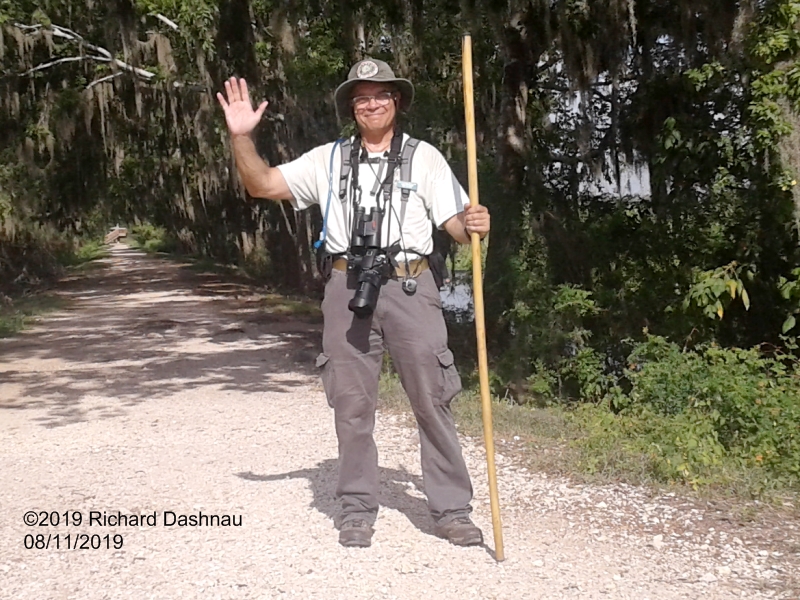
Welcome to Brazos Bend State Park. That's me on the trail at BBSP in August of 2019. One of the most popular reasons for people to visit BBSP is to see the birds. I've collected my pictures of Ospreys,
Hawks, Harriers, etc. here.
----------------------------------
Welcome
to Brazos Bend State Park. That's me on the trail at BBSP in August of
2019. One of the most popular
reasons for people to visit BBSP is to see the birds. I've
collected my
pictures of Ospreys,
Hawks, Harriers, etc. here.
01/28/2024
Good news! We got some water at Brazos Bend State Park. We almost got
too much, since the Brazos River got close to flood stage at
the river gage at Rosharon (about 45 feet).
Big Creek rose enough to overflow into Hale Lake and fill that very
nicely (though I didn't go look, since it that area of the park
was
still flooded.) But that water didn't really go much further
into
the park. Instead, the direct rain that fell on Pilant Lake and Elm
Lake brought up the water levels there,
and along Pilant Slough. I observed that myself. So, here are
a few images from that wonderful sunny day.
It was cold (44.7°F)
up at the 40Acre Parking lot. Although it's usually colder down on the
trails, I was also hoping that the sunny day would warm things a bit.
Through
the past months, I've been stopping just East of the
Observation Tower and taking pictures across Pilant Lake. It looked
great today!

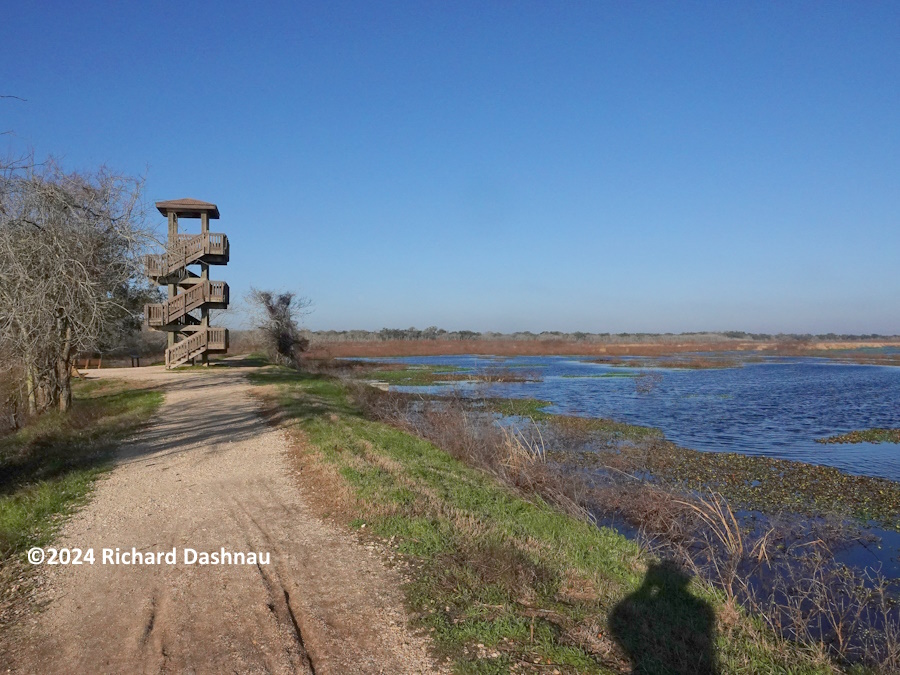

Along the Spillway Trail, there was a Red Shouldered Hawk (Buteo lineatus) in
a tree. This is one of many raptors
that we see pretty often at BBSP. All birds have something
wonderful
that makes them unique. Although I tend to concentrate on a few
specific raptors, I really enjoy hearing the Red Shouldered hawks
screaming among the
concert of various birds and animals calling
at the park (and of course seeing them fly by). In fact, this one
started shouting to another that was calling some hundred
yards away. I see these hawks frequently,
and am often frustrated because they usually get their business done
before I can even get my camera pointed at them.




On 03/11/2023
it was a pretty blustery day at Fiorenza Park. The water was
pretty rough from the wind, and not many birds were active; but I had
some luck anyway.
While
I was walking back to my car, this Red-Shouldered Hawk (Buteo lineatus)
landed on one of the wire support poles. It was facing into the harsh
wind, but it didn't fly while I was watching it.
Of course, as soon as I turned my back on it, the hawk took
off. I saw it fly over my head.
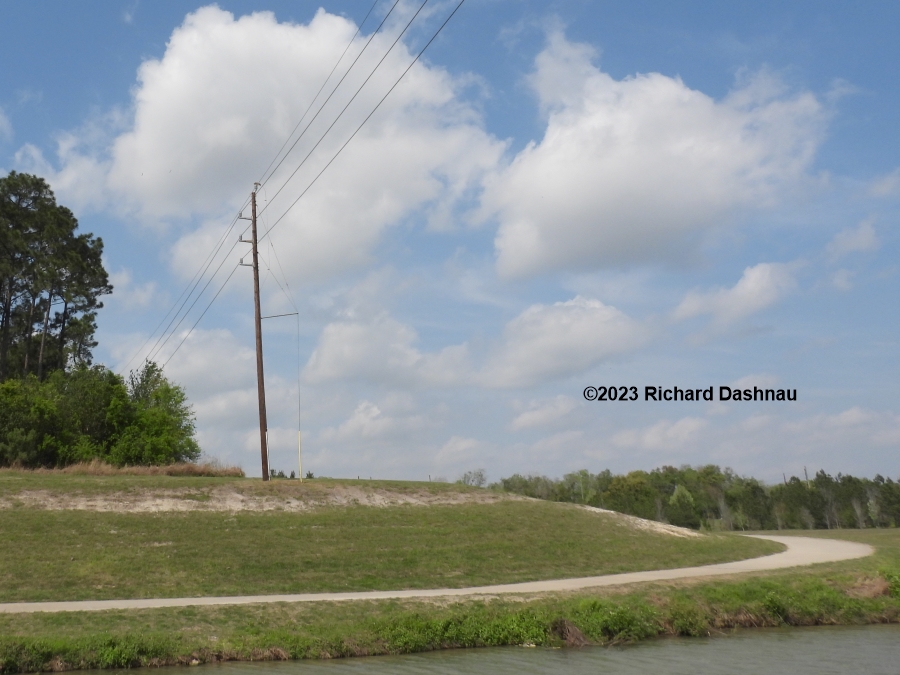
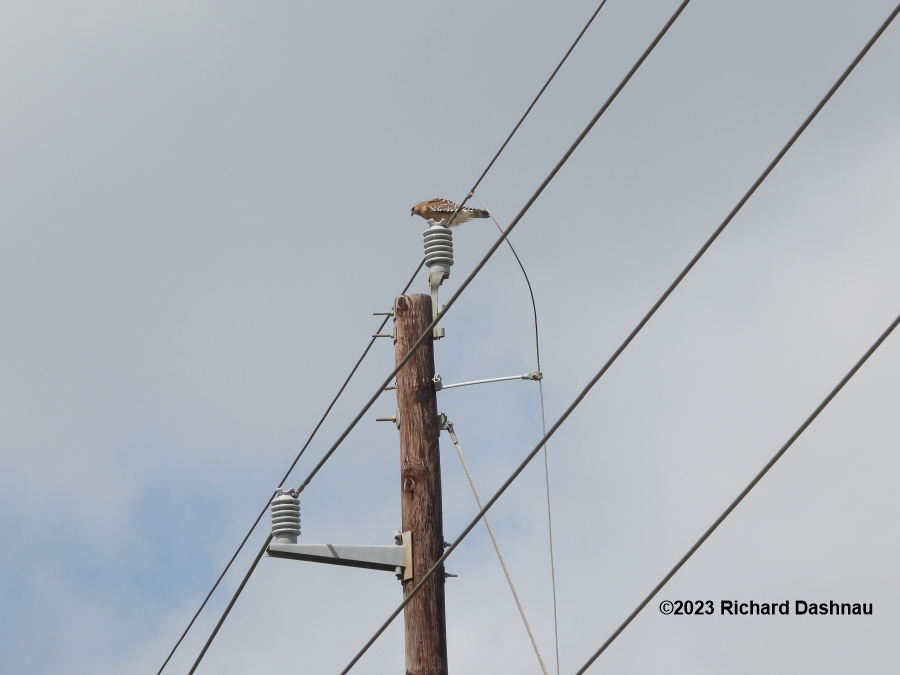
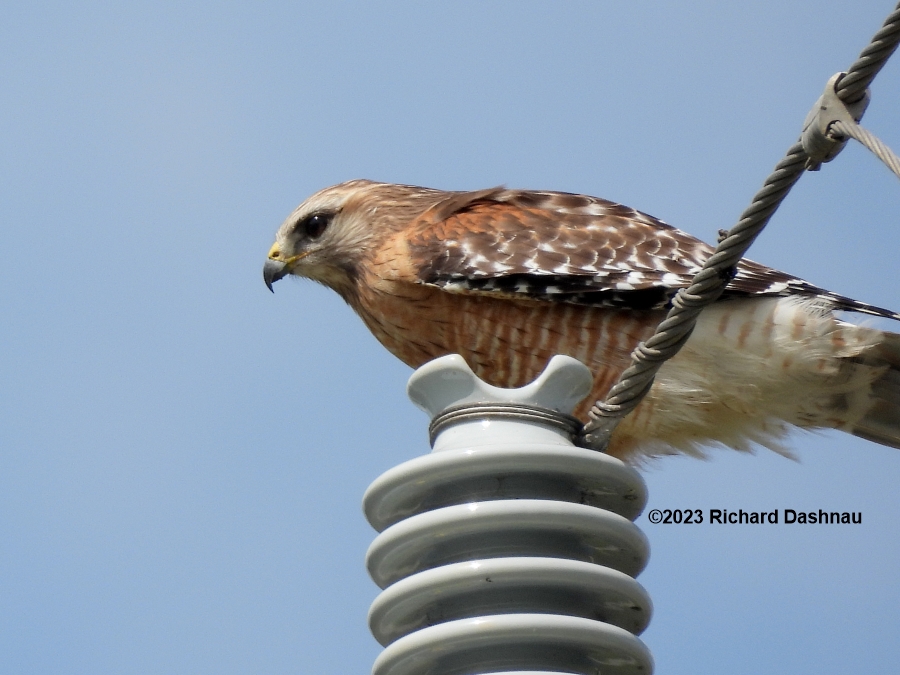
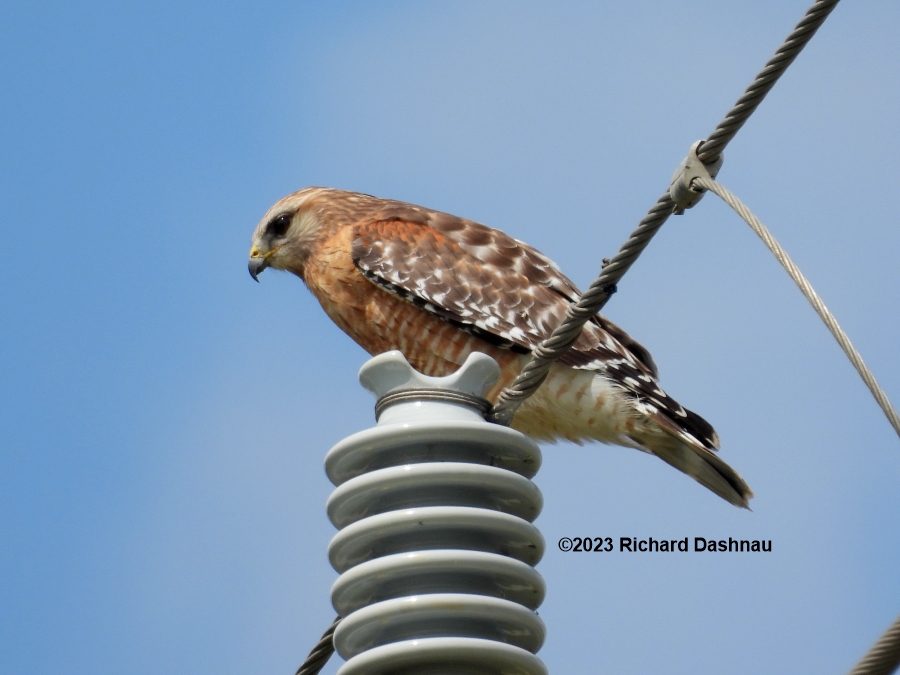
09/25/2022 At Brazos Bend State Park, various
park visitors mentioned seeing baby alligators and their mother
near the concrete culvert by the 40 Acre Lake
Observation Tower. When
I went back there, I couldn't find the babies at first, but I did find
a Great Blue Heron. After it stalked away a few yards, I heard some
baby alligators chirp. I still
couldn't see them. I stepped
away from the culvert, and the Heron stalked back. Another Great Blue
Heron appeared and chased off the first one. I waited, thinking that
I'd soon be observing
some drama involving a Great Blue Heron and
some baby alligators. But, the second Heron moved closer to the bank,
and I couldn't see what it was up to.
A few minutes later, a
Red-Shouldered Hawk landed in the grass about 13 yards from me!
I
lost it among the plants, but started shooting video of the area in
case the Hawk took off with
prey. It did take off--not where I
had the camera pointed. It hadn't caught anything. As I stood there,
waiting for drama, I noticed furtive movements in the plants at the
edge of the trail.
I thought that something was being chased, and
I thought that a snake might be hunting there. Suddenly, a Bullfrog
jumped out, crossed the trail in a few leaps and entered Pilant Slough.
Then,
a few more frogs
hopped out! I started shooting video, and was trying to focus on the
last frog....
...when the Hawk returned! The Hawk grabbed the frog, and
flew East down the Spillway Trail. I caught this on video, and
edited the video into this file. It's
not great video, but it's worth a
look.
The images below are frames from the video. The video looks a
bit
better than the images might imply. The original is just a few seconds
long (and the Hawk's grab is in it for a frame
or two)--but I've
slowed it and cropped it to clarify the activity. We can
clearly
see the frog being carried down the trail, probably traveling faster
than it ever had before.
Later, I realized the the Bullfrogs might
have been flushed out of the water by the Great Blue Heron that I'd
lost sight of below the bank. By the way, I discovered where
the
mother alligator
was when she surfaced and rushed at the same Heron--which flew away.
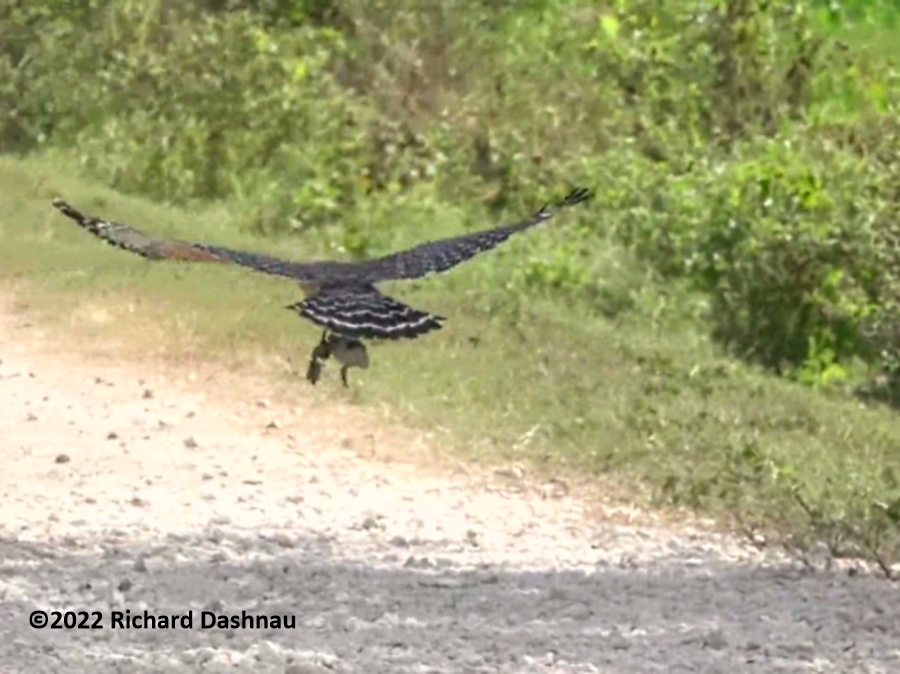
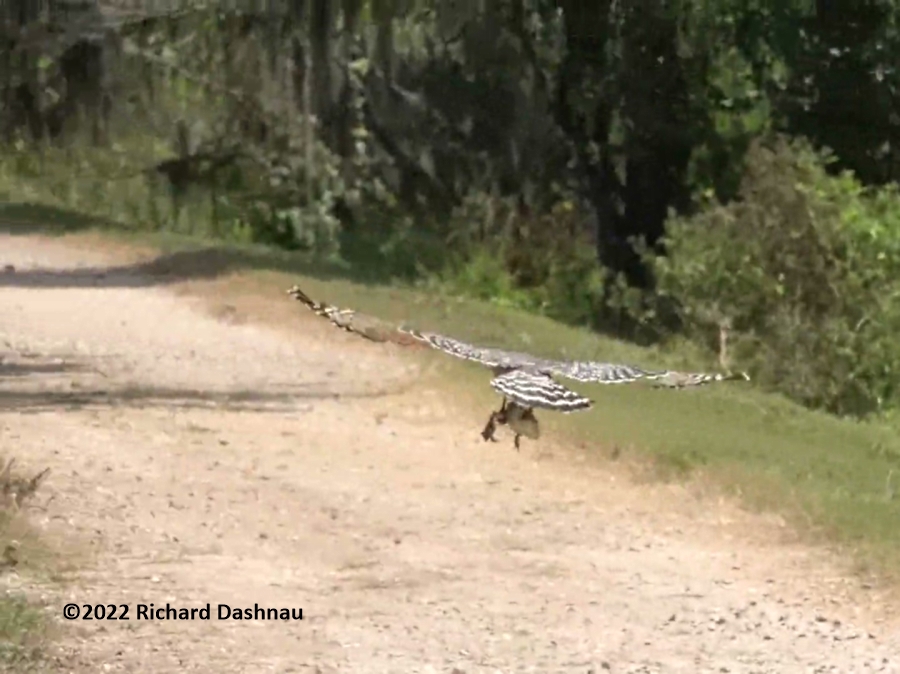
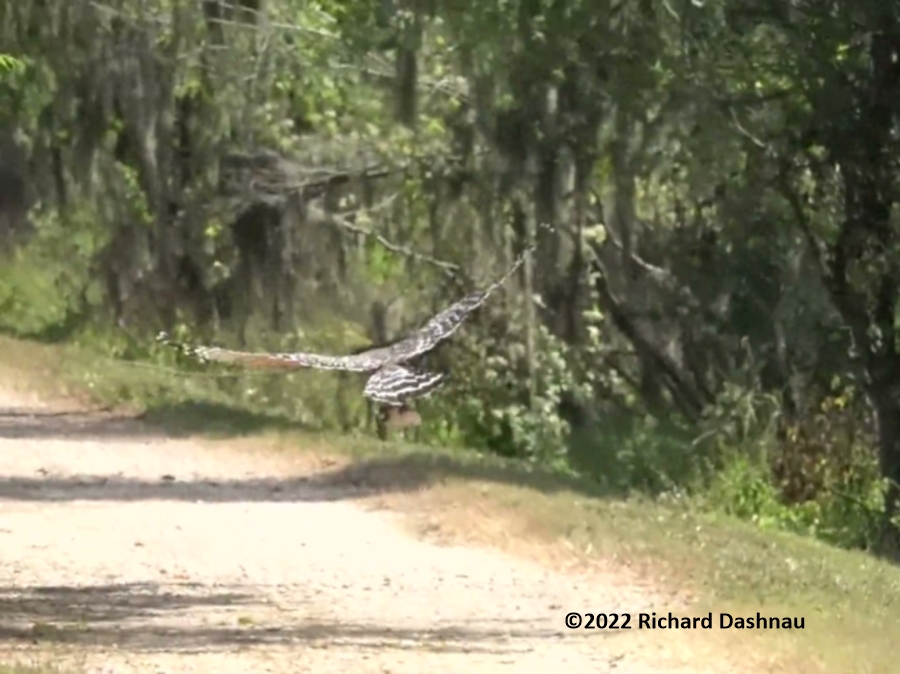
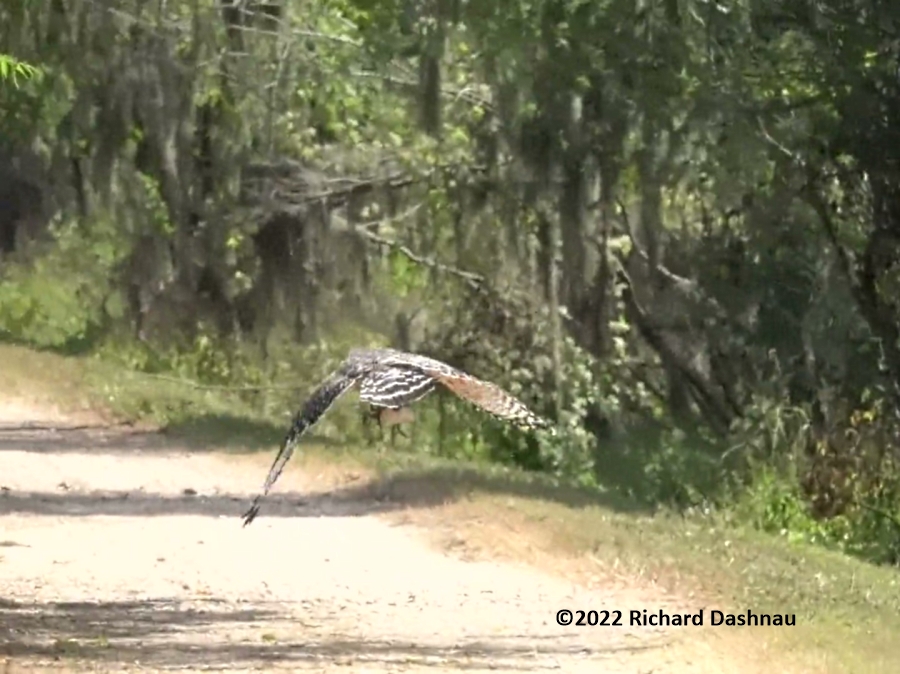
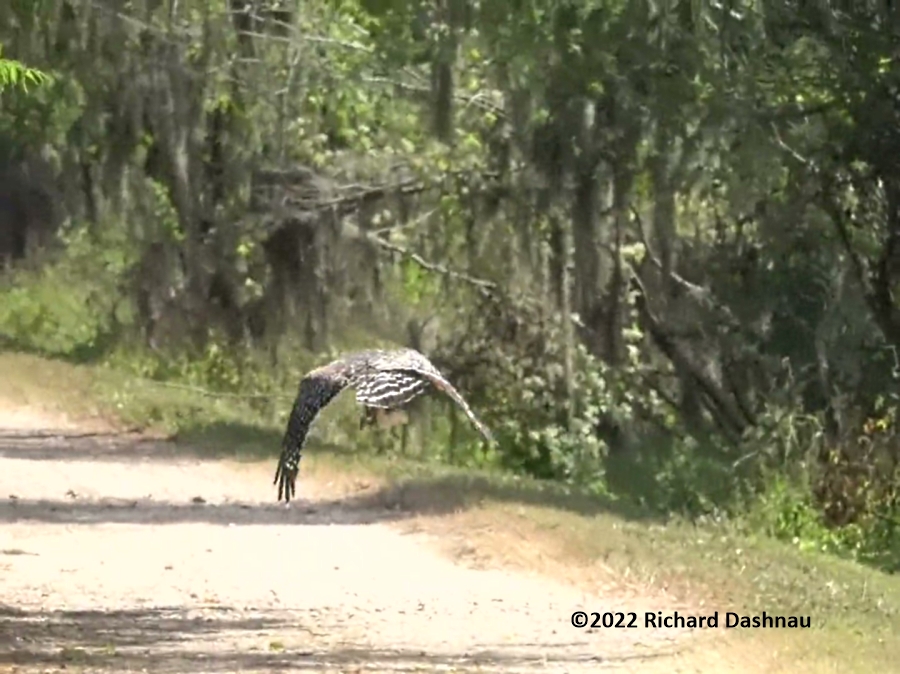
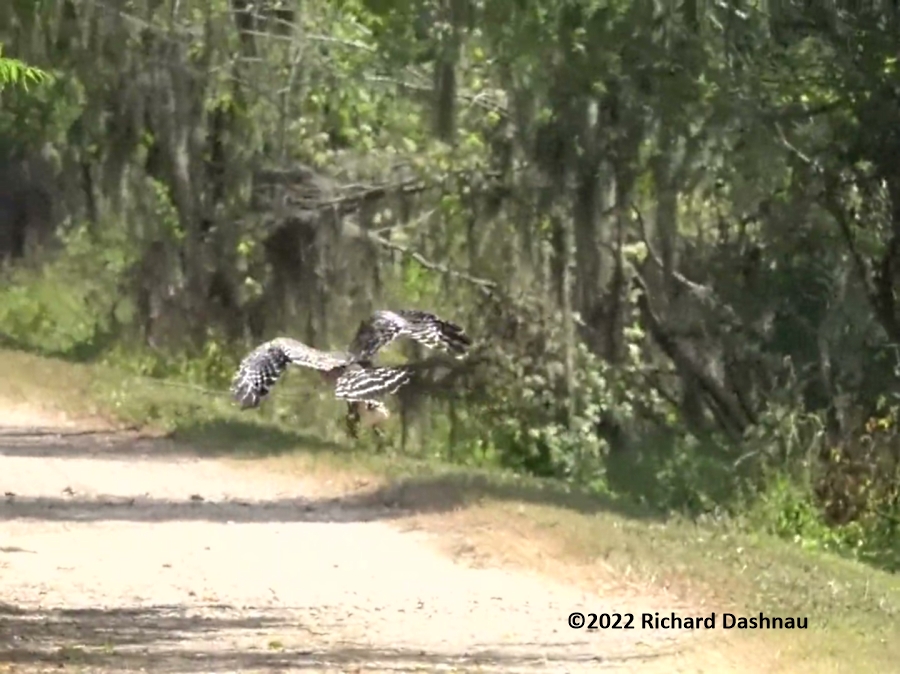
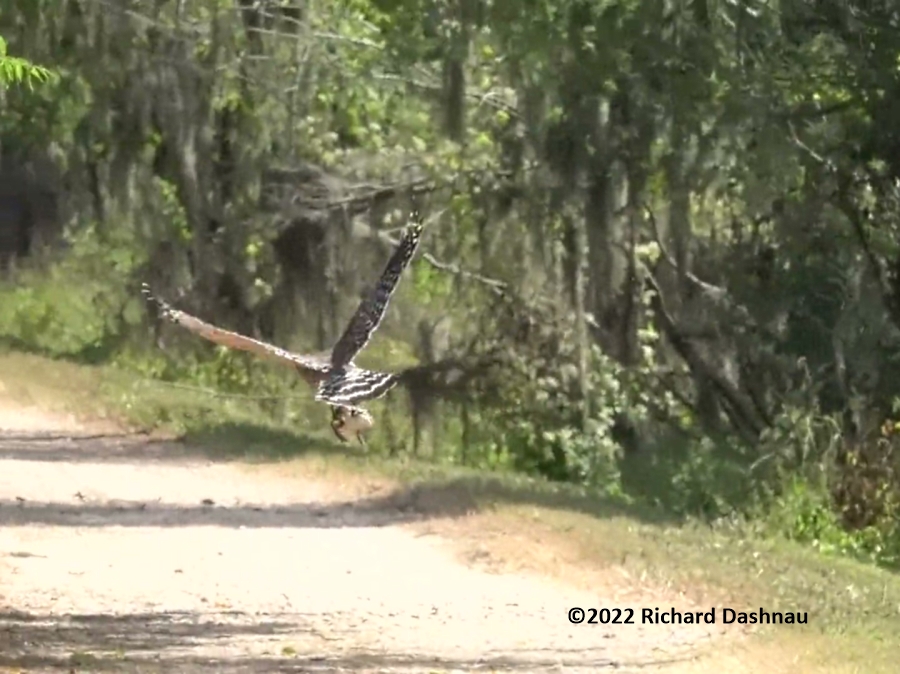
From BBSP on 04/24/2022. Springtime has brought new
life and activity to the park. I went to Live Oak trail to
look for
Limpkins and pink eggs. At first Limpkins were around, but
not
very busy
on our side of the fence. I saw a Red
Tailed Hawk drop down onto something in the plants, then fly off with a
frog. When it landed in a tree, I could see it that it had a small
Bullfrog.
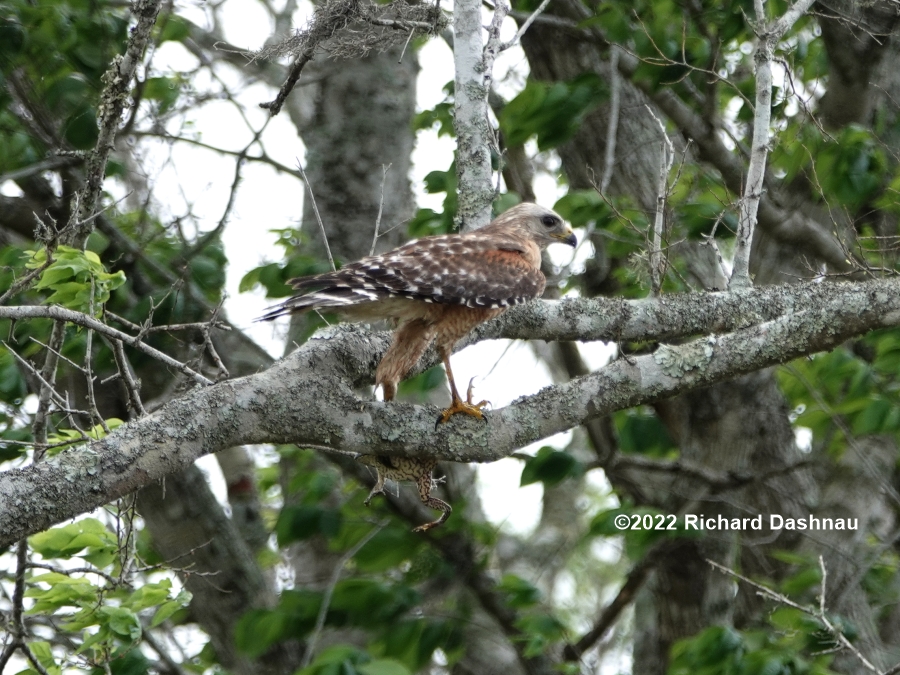
At BBSP on 01/30/2022.
About 50°F Brazos
Bend State Park when I got there. Instead of watching over Pilant Lake,
I decided to head down the Spillway Trail to
Otter Island (about 800 steps
East
of the Tower) to look for Otters.
No luck on this day, but here are some observations. Pictures first, in
general order as they happened. This Red Shouldered Hawk (Buteo
lineatus)
was
above the trail and watching...well, me, I suppose.
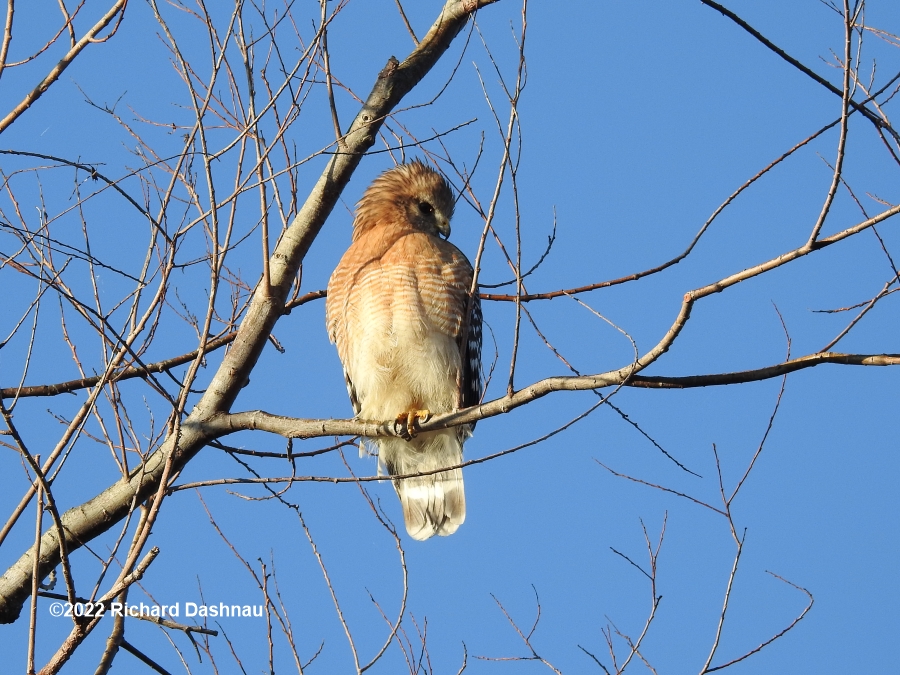
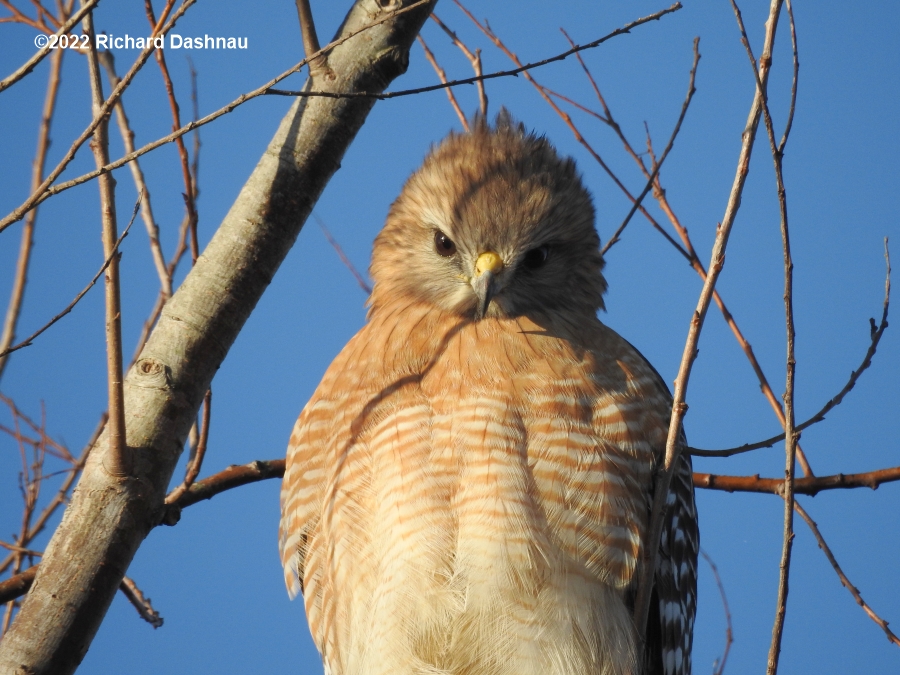
01/16/2022.
Another cold day at Brazos Bend State Park. Please note that there was
movement around me most of the time, so the animals that I mention were
not
the only
ones about. I walked to the observation
tower and the open waters there, hoping to encounter otters
and/or
eagles. At 8:30am I stopped by the gator mom's den, and she was
visible, but just the tip of her nose was exposed. It was about 39�F
on
the trail.
On the way back to my car at 2:30,there was red shoulder hawk
on a stump.
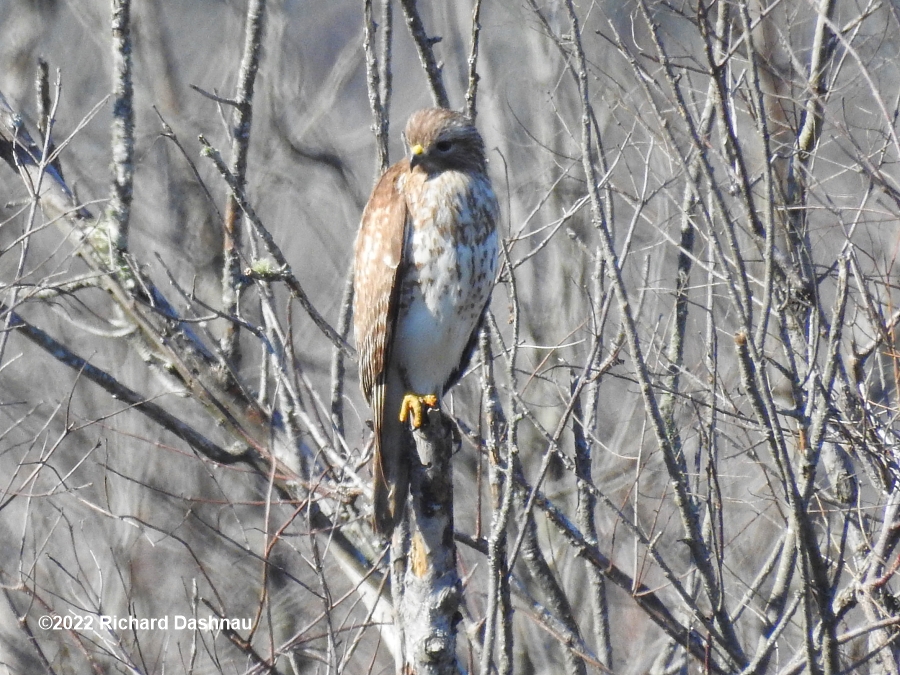
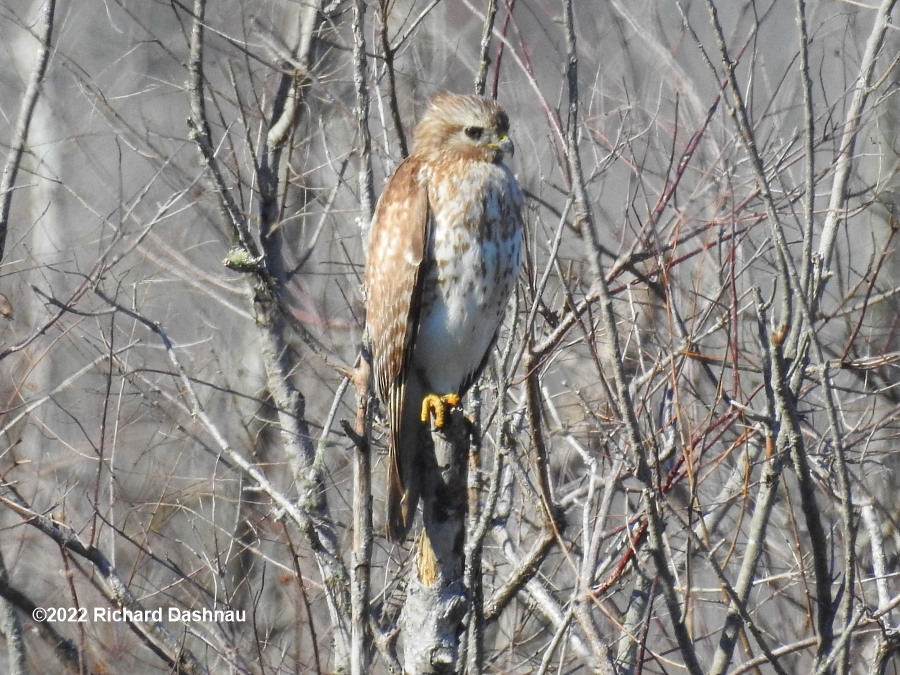
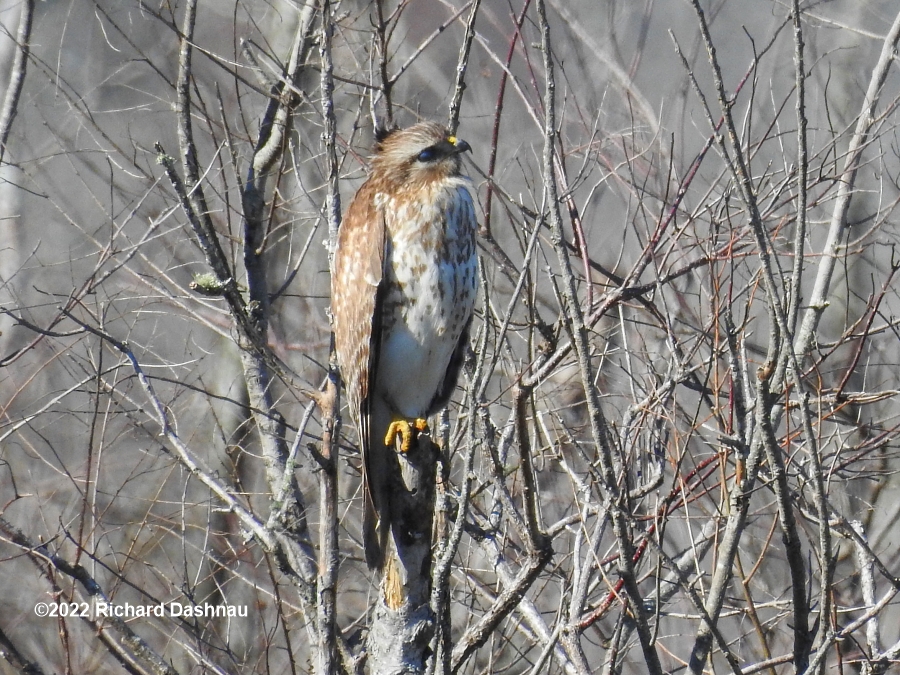
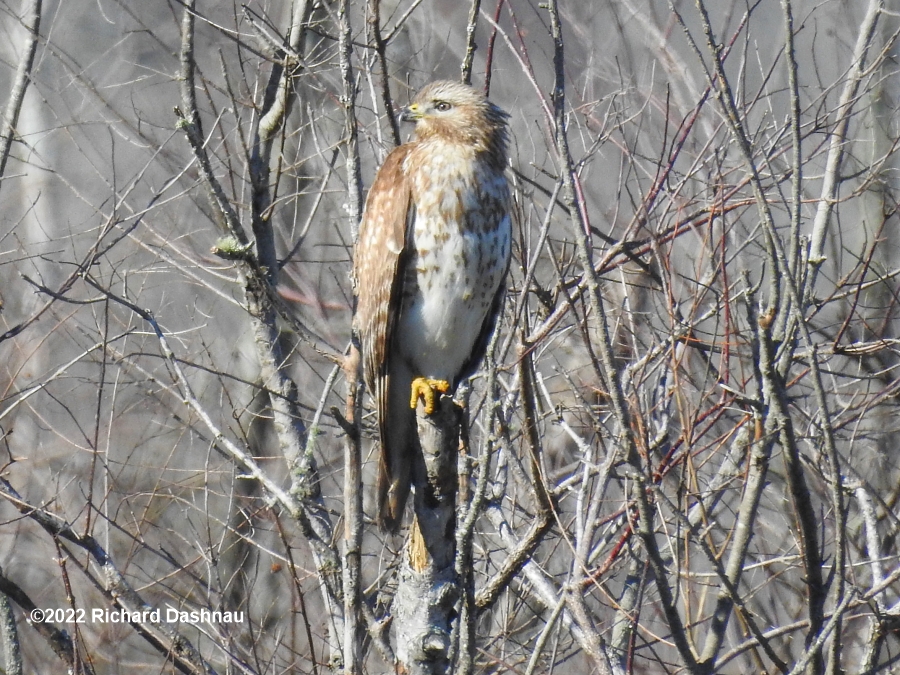
On 11/28/2021;
I arrived at BBSP, and as I entered 40 Acre lake trail at 8am, this
Red-Shouldered Hawk was at the top of this dead Oak Tree (tree was
killed by lightning some time ago.
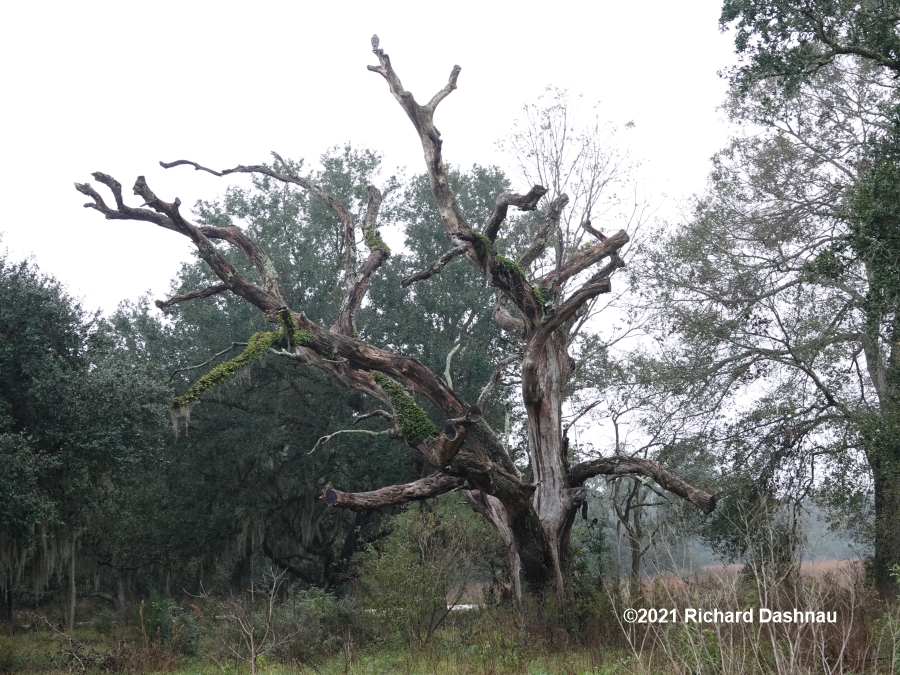
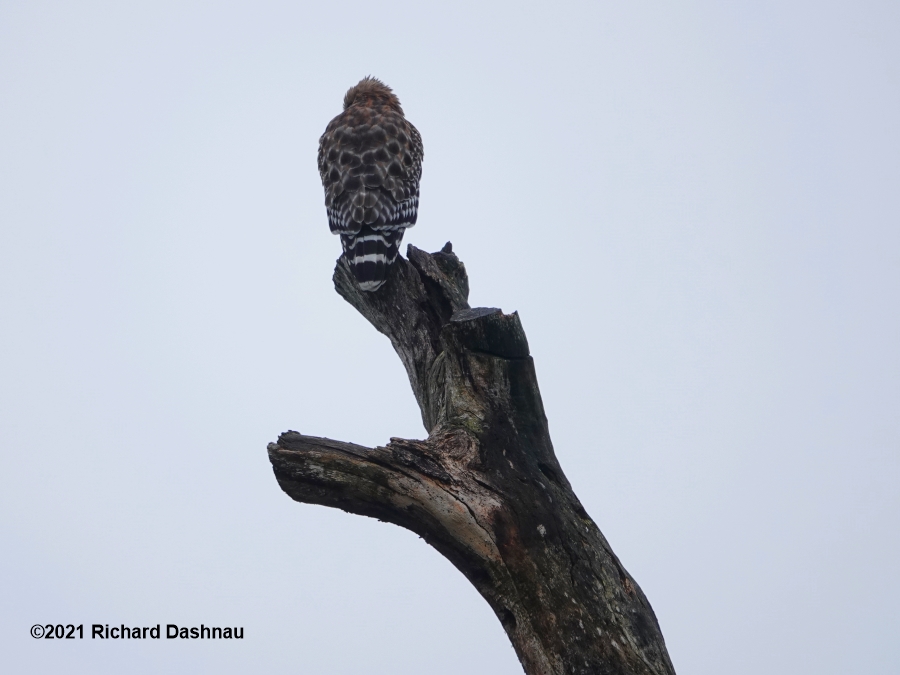
When I got back to
my car at 9:40, the hawk was still in
the tree. I had just put taken my camera strap off and placed it in the
trunk, when the hawk started calling--and
was answered by
another hawk behind me. I grabbed my camera, shot some photos, and
stared shooting video. Another hawk flew out and landed next to the
first one. Then they both called, and
finally flew off.(The
video clip is here.) I left, and got
back in time for my hike.
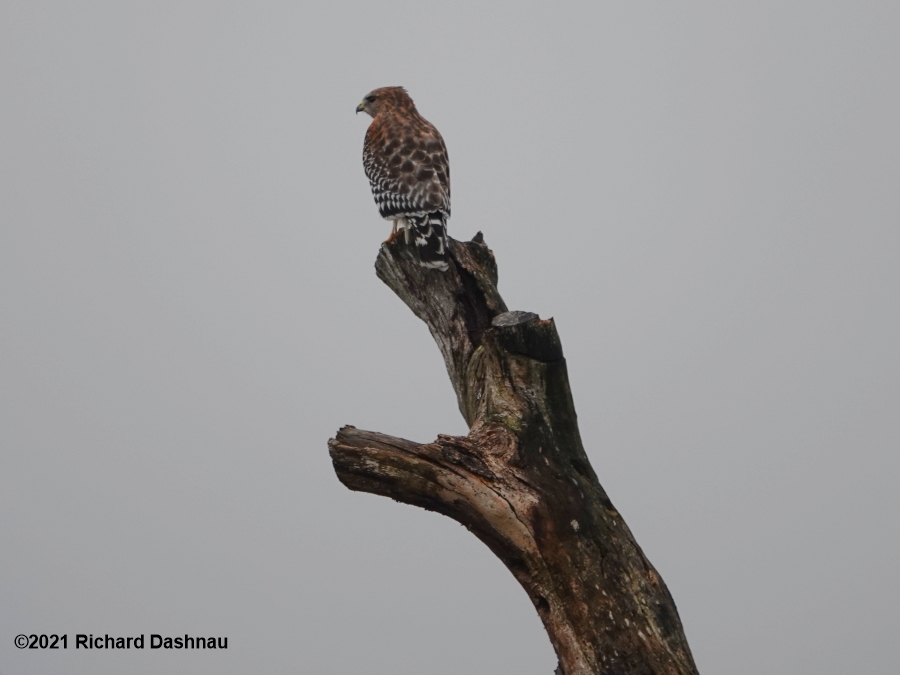
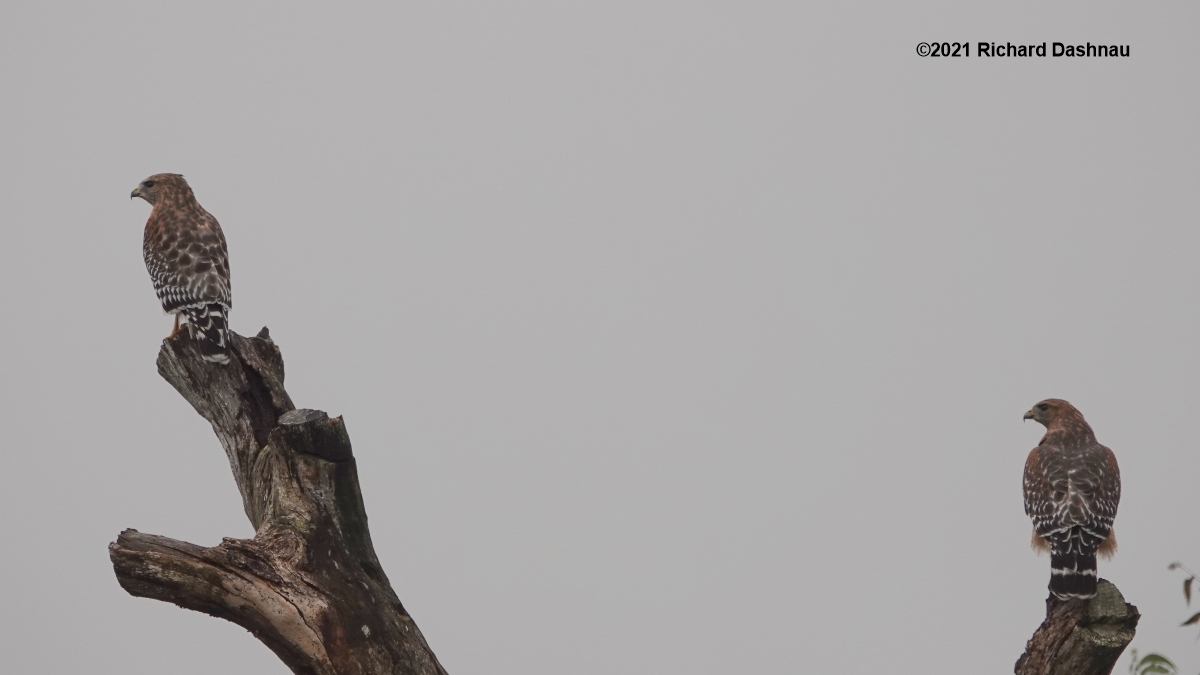
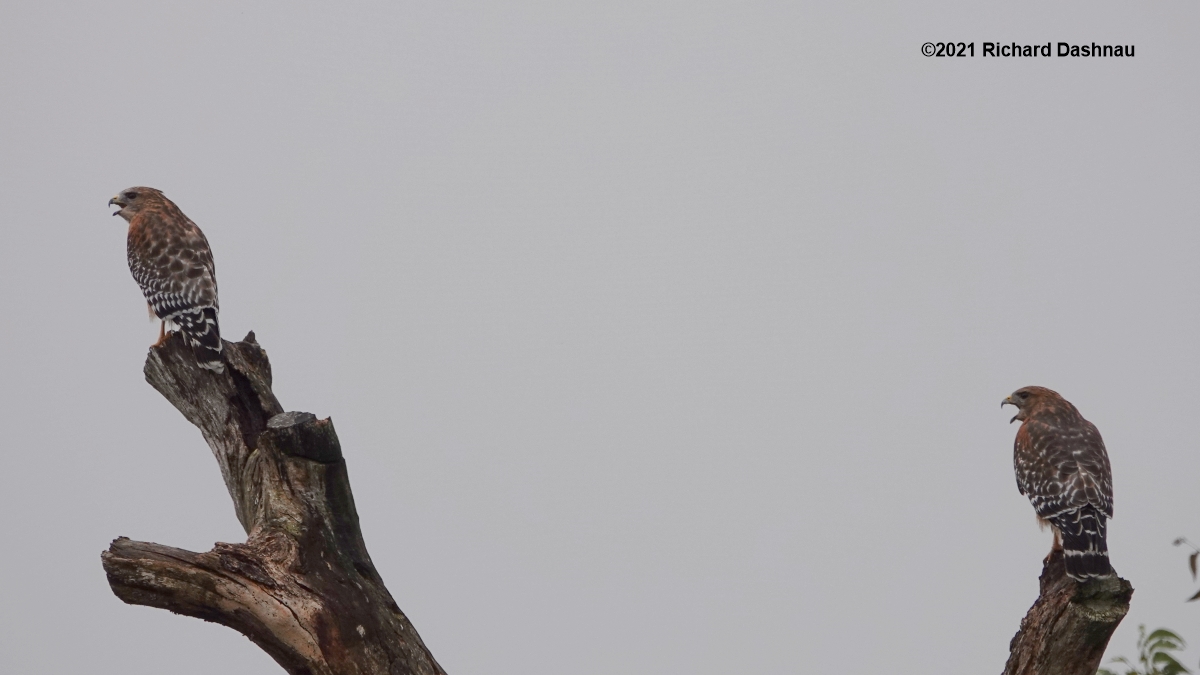
On 11/07/2021;
I parked in the 40-Acre Lake parking lot. I opened the car
door,
looked out, and saw this Red-Shouldered Hawk (Buteo lineatus) perched on
the
sign about 20 yards away. I quietly got out of the car, carefully
opened the trunk, and was able to get the camera without scaring the
hawk. So, here it is.
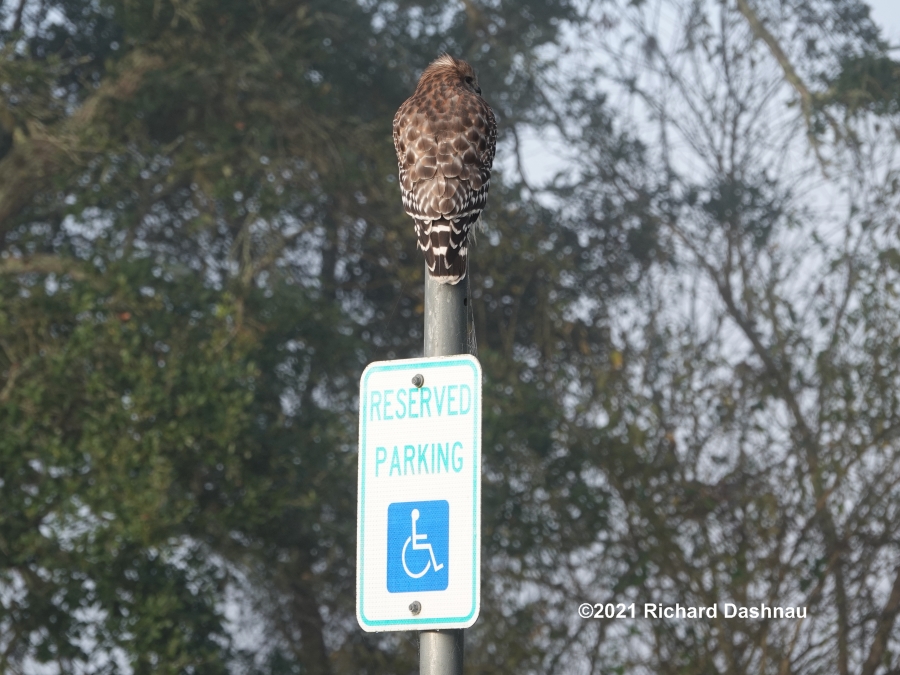
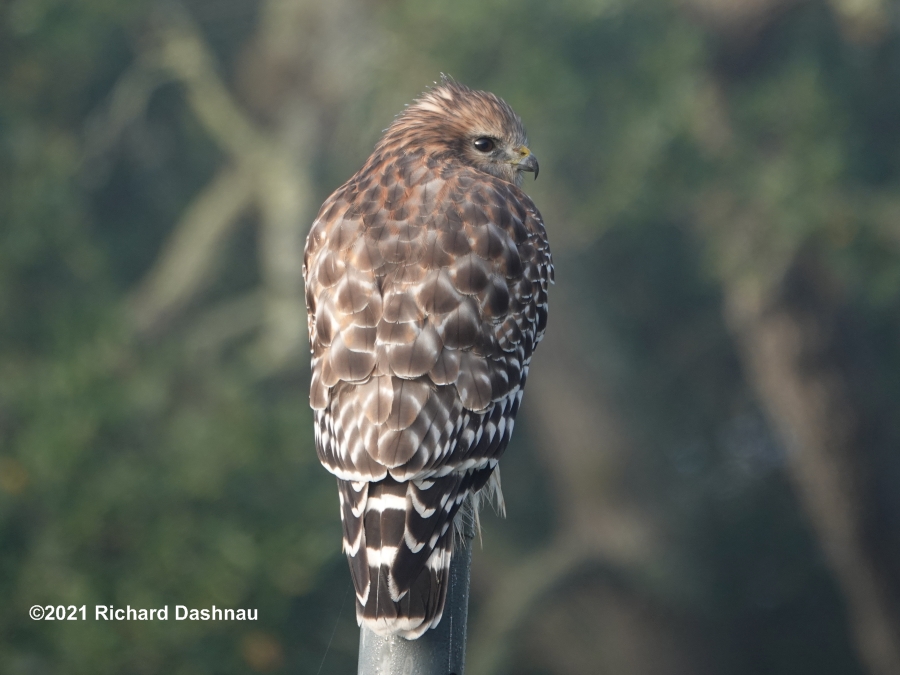
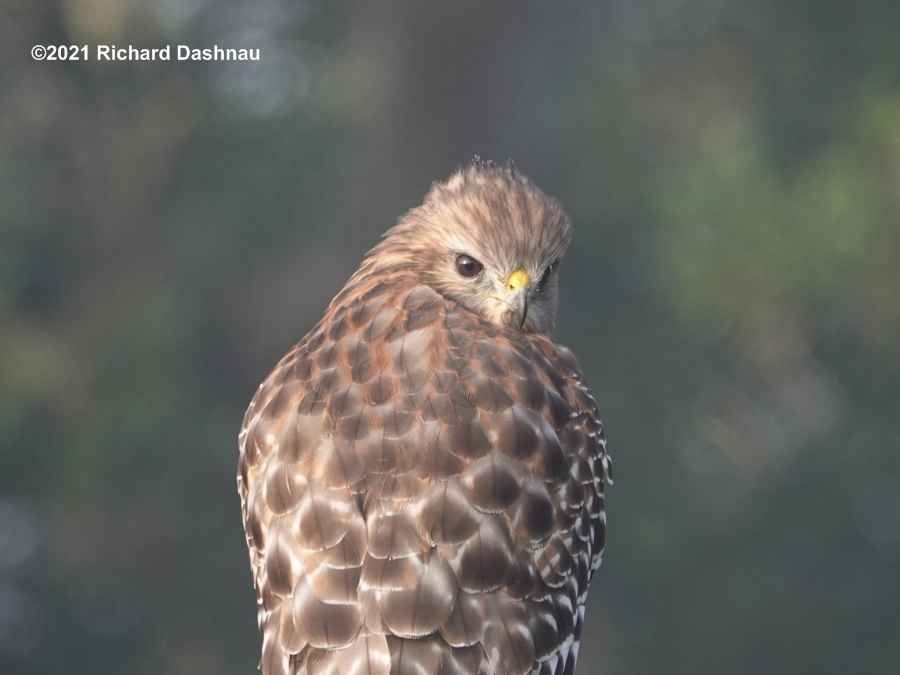
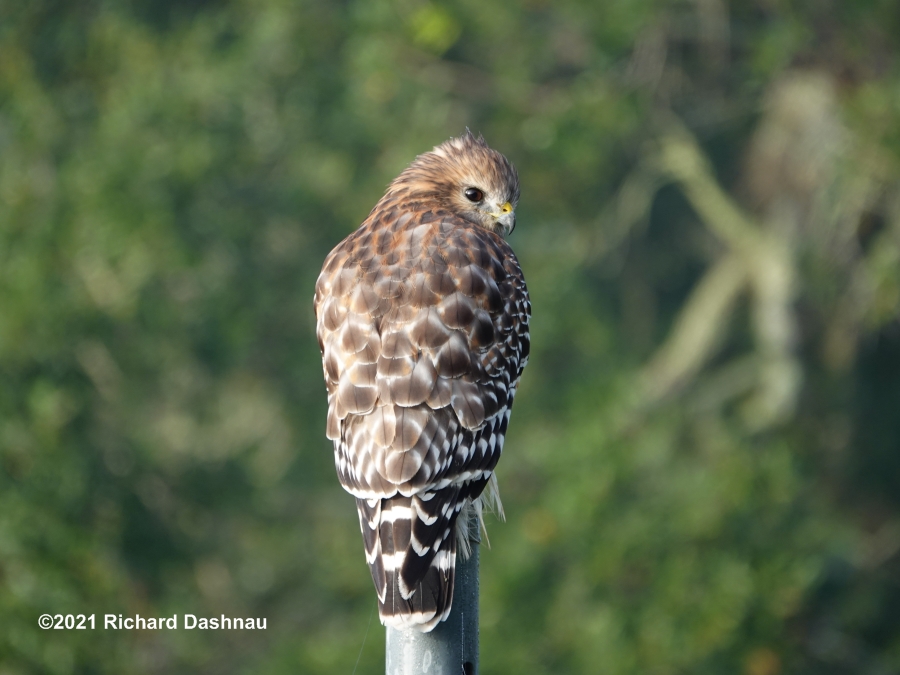
This was about 7:30, and
there was mist in the air.
I stayed near my car and watched. I was a bit surprised that
the
hawk didn't move. Since it seemed reluctant to fly off, I
scanned
the trees around for another raptor, but didn't see anything that might
be a potential threat for the hawk. That doesn't mean that there wasn't
anything around, though.
I watched for about 20 minutes. During this
time, visitors that had arrived to take the "bird hike" also came over
to look at the hawk. Also, the sun burned off the mist and lit
up
the hawk. After growing tired of the gathering people, it flew off; and
I continued to 40 Acre Lake-where Caracaras were busy.
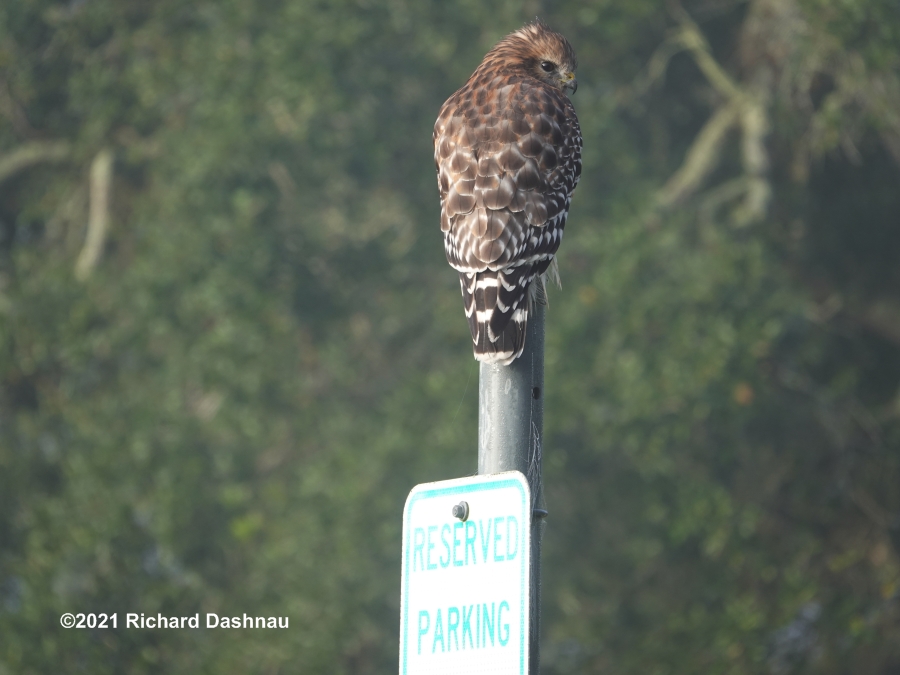
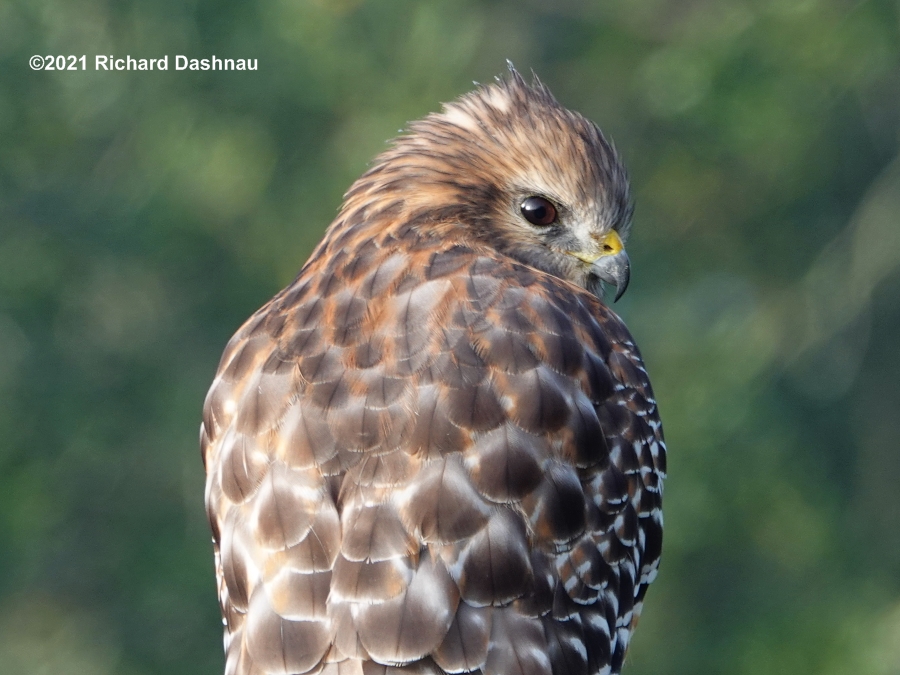
04/10/2020
Like almost everyone these days, I've been staying
inside. I have stopped driving around outside
for...recreational purposes.
BBSP
is just too far away, AND, entrance protocol to the park has changed
dramatically (even for volunteers). So...I haven't been going there.
The
parks within the city are also out of reach for similar reasons-plus
the large number of visitors. But on 4/10, while I was in another
neighborhood
performing my job, I noticed a Red-Tailed Hawk take off
from nearby parking lot. Considering where I was, that was very
unusual. I noticed
that it was carrying something. It landed about
70 yards away on top of a tall parking lot lamp. It appeared to be
eating something.
So I grabbed my camera from the car (which I'd
happened to be standing next to), and tried shooting some photos, but
mostly video clips.
I have better luck cropping video than photos.
I could only spare a few minutes for this, and then had to
return to
the tasks at hand.
The resulting clips were a bit shaky, since I'd
shot them while resting my arms on the roof of my car, and was a bit
excited about it.
But I cropped them, and slowed them 4x (I filmed at 60fps and
reformatted to 15fps). I think they turned out fairly nice.
The resulting
edited video is about 10 minutes long, and shows a Red-Tailed
Hawk (Buteo jamaicensis) enjoying breakfast (video
was
filmed at about 8:30 am). I think the prey was a bird (There
appears
to be evidence of feathers, and possibly a wing or two as
the
hawk eats). Unfortunately,resolution isn't really sharp (because of the
cropping). Still, I think watching how swiftly the
hawk cuts and pulls parts away-without teeth-is interesting.
The images below are frame grabs from the video.
Even though I haven't been out to see predatory Nature...it came and
found me anyway. How cool is THAT?
. 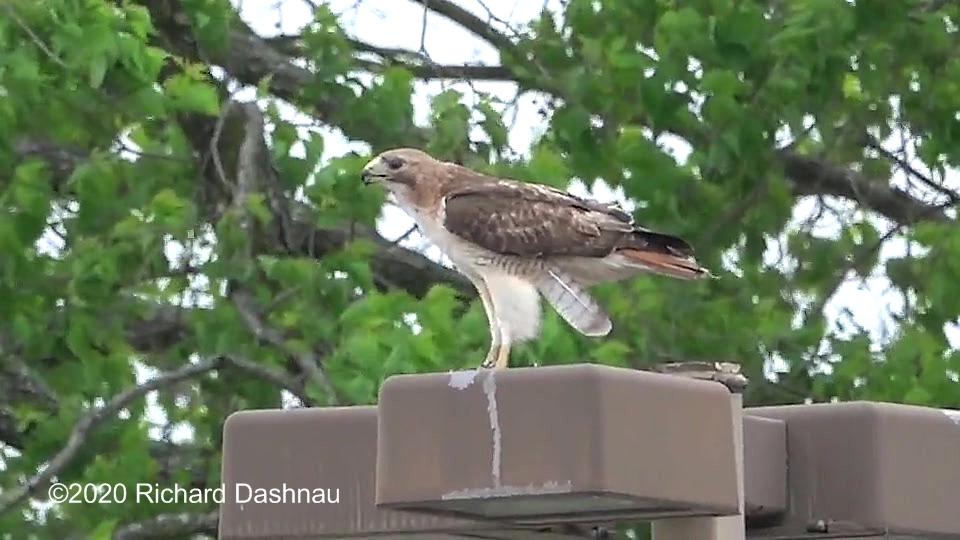
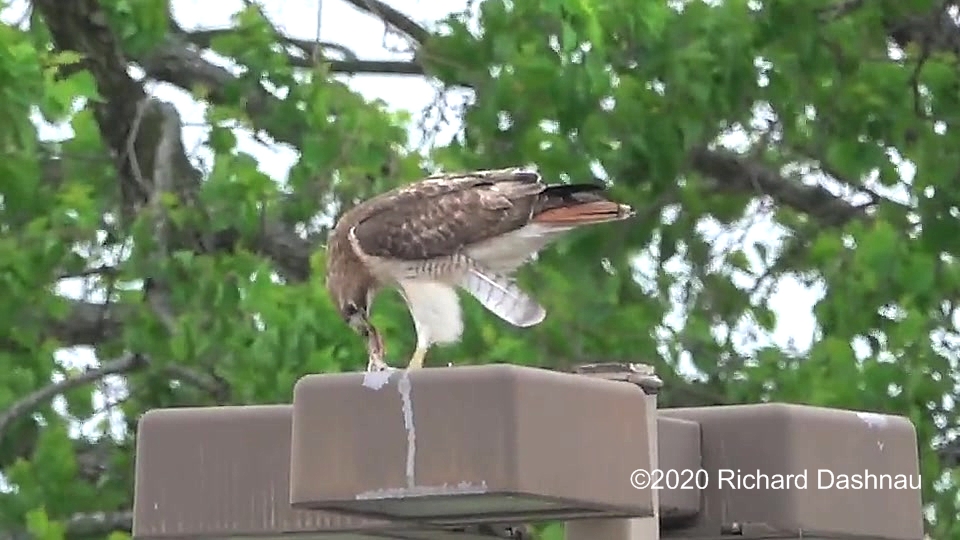
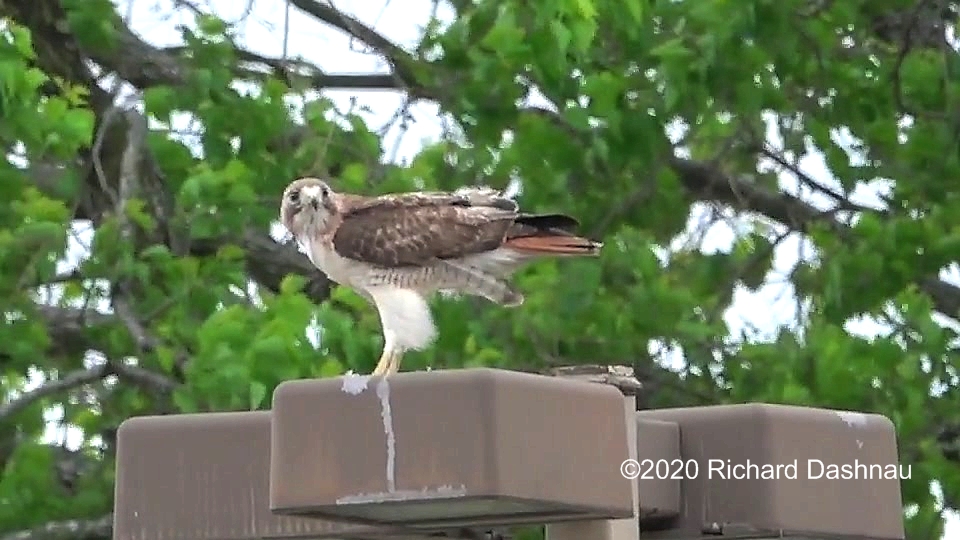
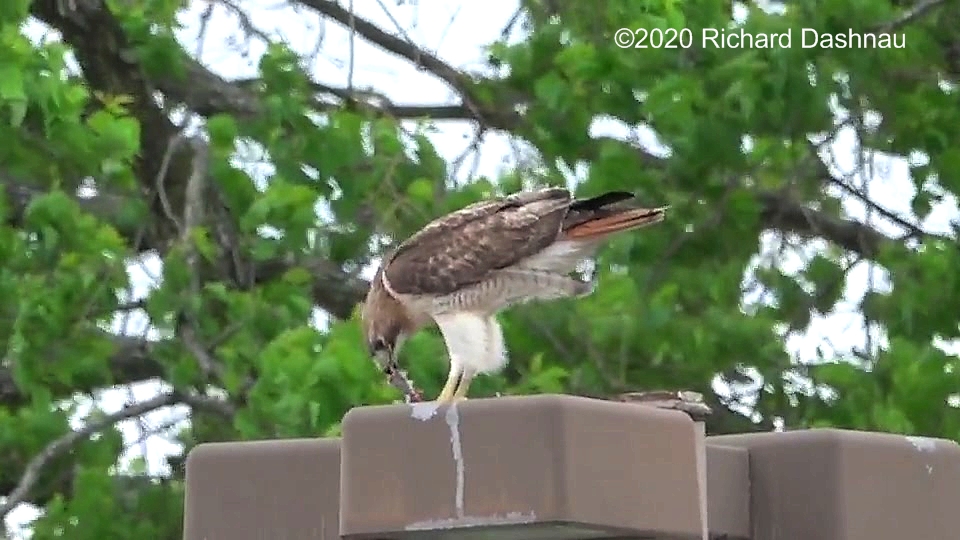
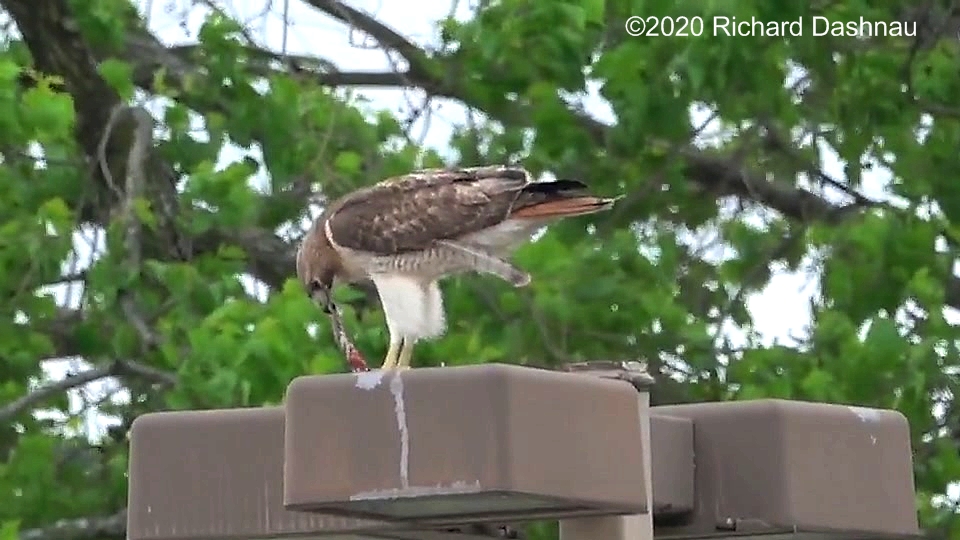
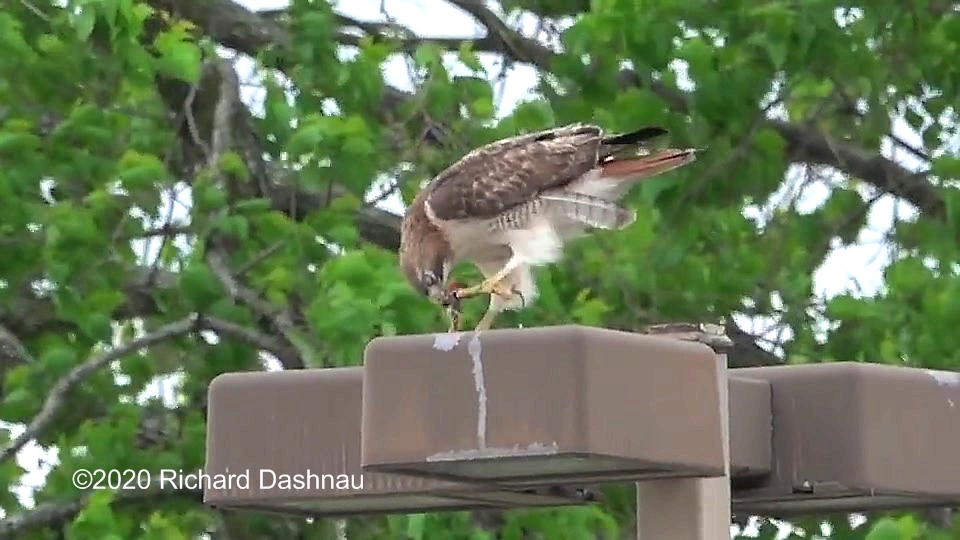
11/16/2019 I
was at Fiorenza Park when I noticed a hawk flying towards me from about
300 yards away. It landed in a tree about 100 yards from me. I turned
away to
look for other activity. After just a few minutes, I
heard the loud cawing of a flock of crows. I figured that the crows had
found the hawk, so I turned the camera that way.
I was able to pick
up the crows and hawk, and I shot video of them as the flew away. I've
edited the video a bit, cropped and slowed it down, and have made a
longer view
of this brief event. The images below are croipped from frame grabs
from the video. Click on each one for a larger view. Click here
for the video.
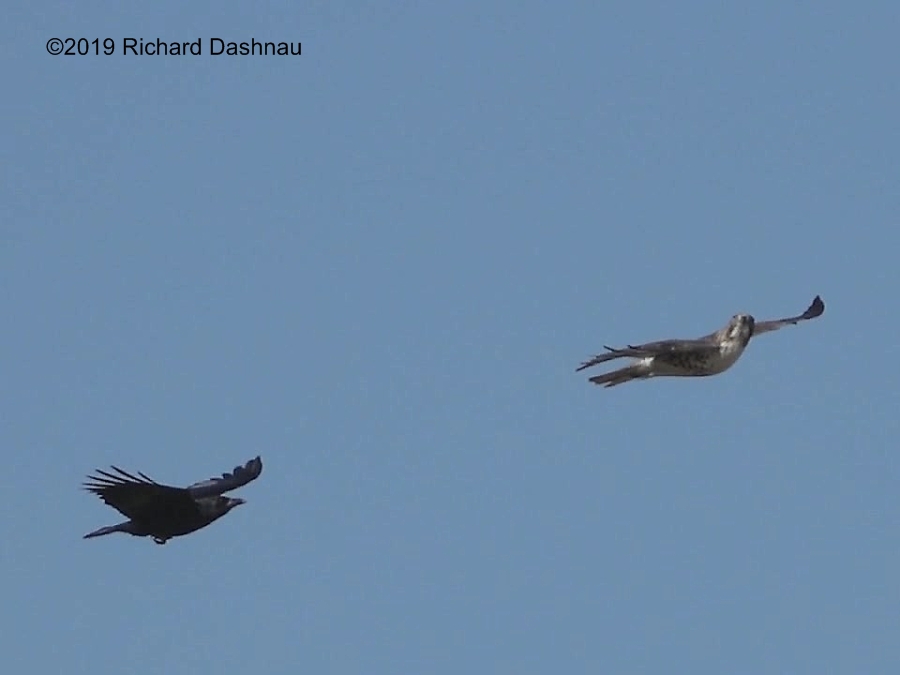
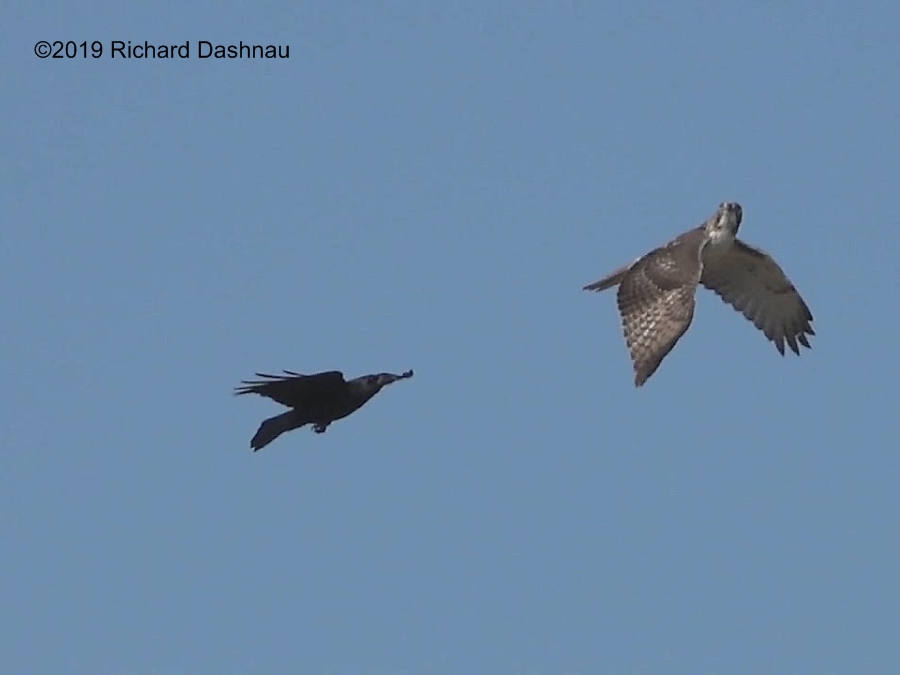
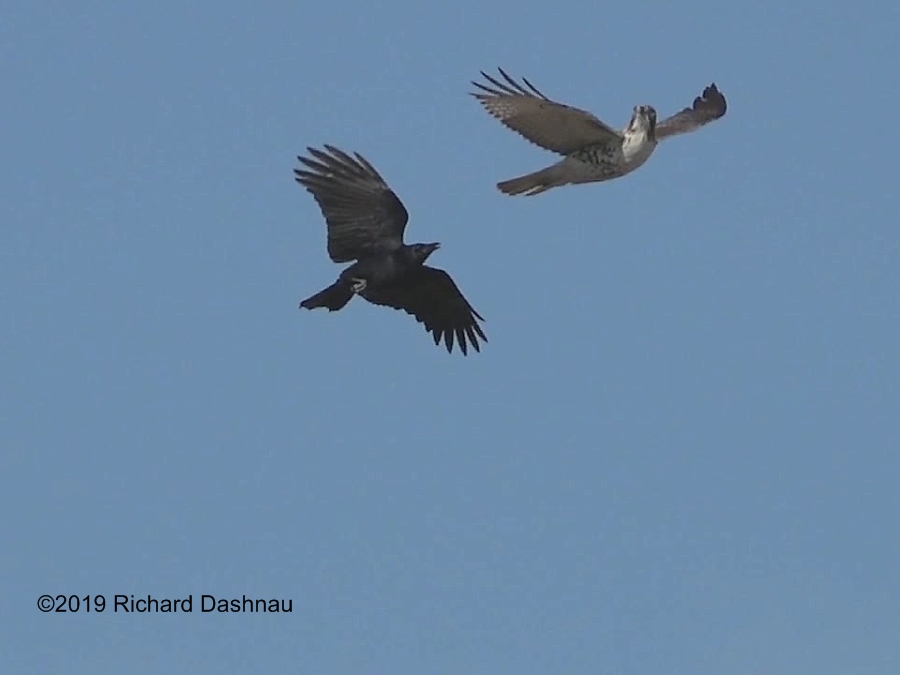
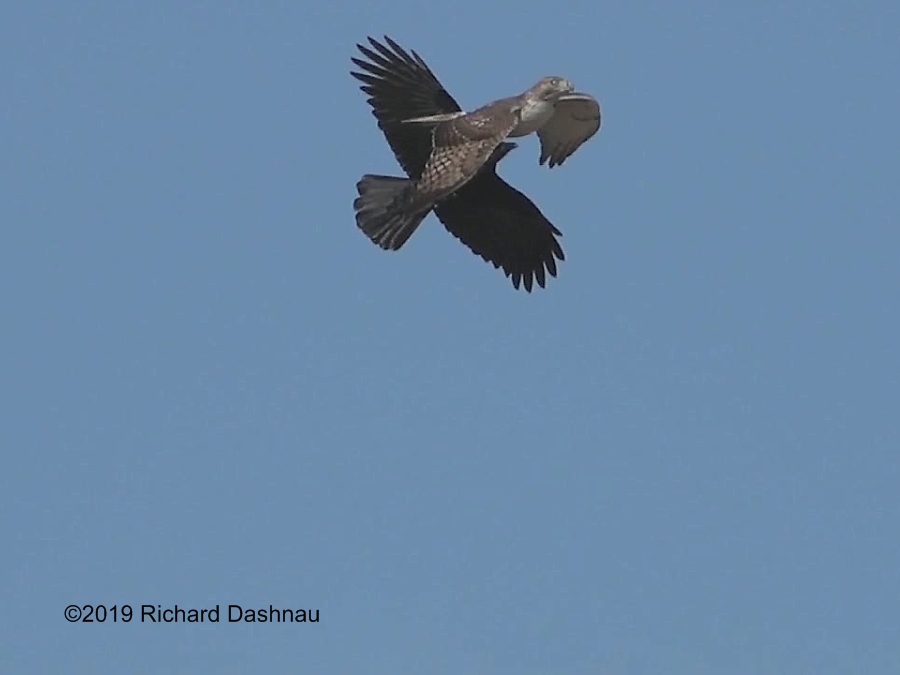
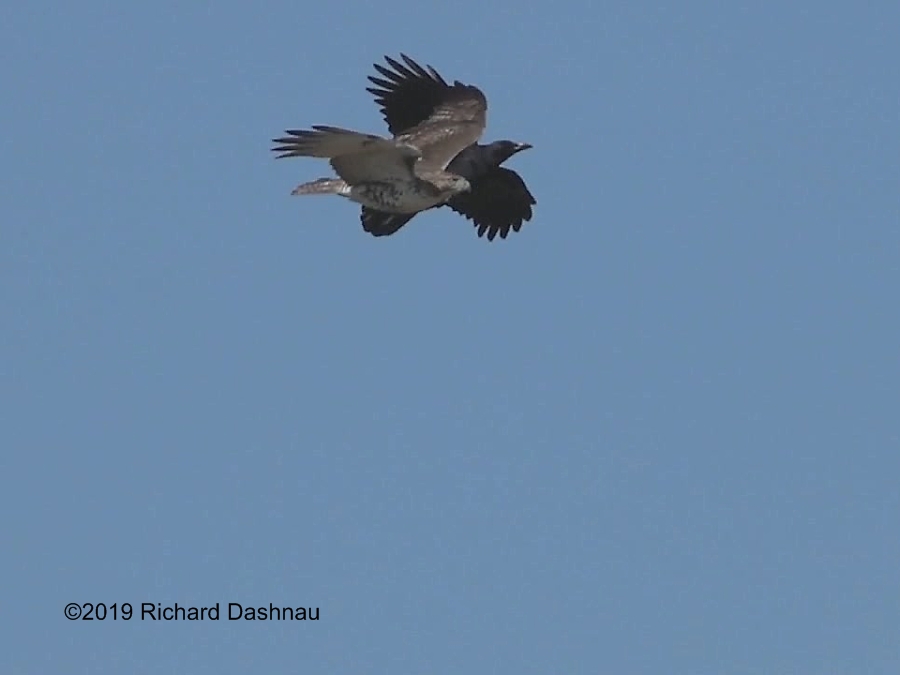
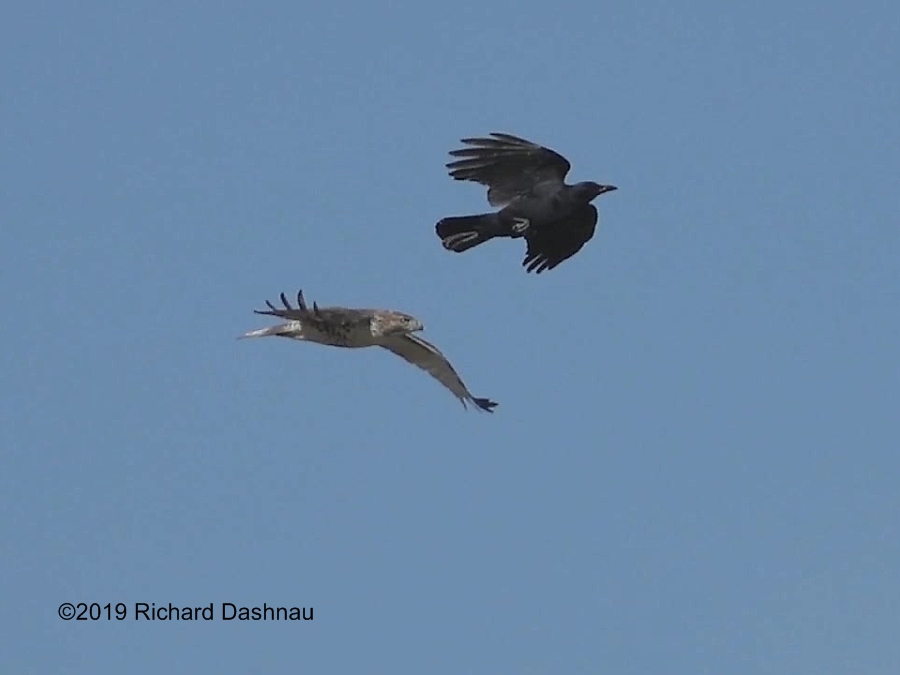
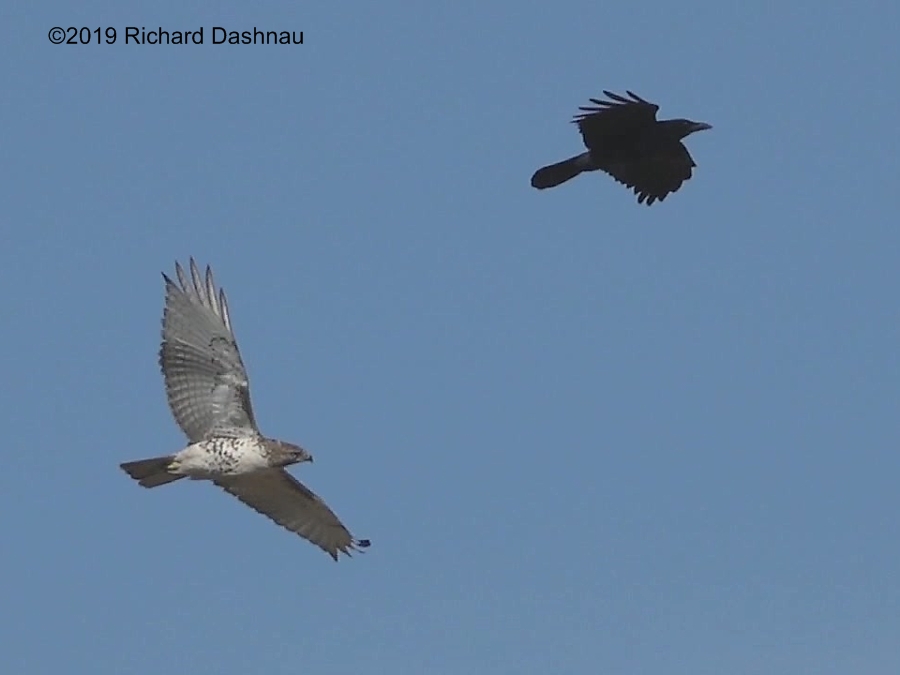
I
couldn't tell what kind of hawk I'd seen, until after I cropped the
video and slowed it down. By looking at the markings, I think
that this was a juvenile
Red-Tailed Hawk (Buteo jamaicensis).
The crows are probably American Crows (Corvus
brachyrhynchos).
I found some brief references to crow
"mobbing" predators
behavior in my two Sibley bird books (Sibley Guide to Bird Behavior
first edition Page 413; Sibley Field Guide to Birds of
Eastern
North
America p286
). I've seen crows harass predators before, and even have a
few examples among my pages. On this
page a single crow (not a "mob") harassed
a bald eagle on 3/20/2016. And, on this
page, a few crows are harassing a juvenile Great Horned Owl
on 3/20/2006.
11/22/2018
(updated 04/25/2020)
Like almost everyone these days, I've been staying inside. I
have stopped driving around outside
for...recreational purposes.
BBSP
is just too far away, AND, entrance protocol to the park has changed
dramatically (even for volunteers). So...I haven't been going there.
So, I'm going through my older material
to post cool things I hadn't gotten around to.
11/22/2018 I
was at Fiorenza Park when I noticed a hawk near some crows. I
know that crows often harass raptors--a single crow will, and
a
group will (this is callrd "mobbing").
So I started shooting video. I was a few hundred yards away.
The
resulting
edited video
is about 5 minutes long, and shows a juvenile hawk which, according to
Lauren Helton (twitter @tinylongwing) is an immature
Red-Shouldered Hawk (Buteo lineatus)
foraging. At the distance I was
filming from, I couldn't tell what it was looking for. The
crows were there at first, but their behavior with the hawk
was
not what I expected.
The images below are frame grabs from the video.
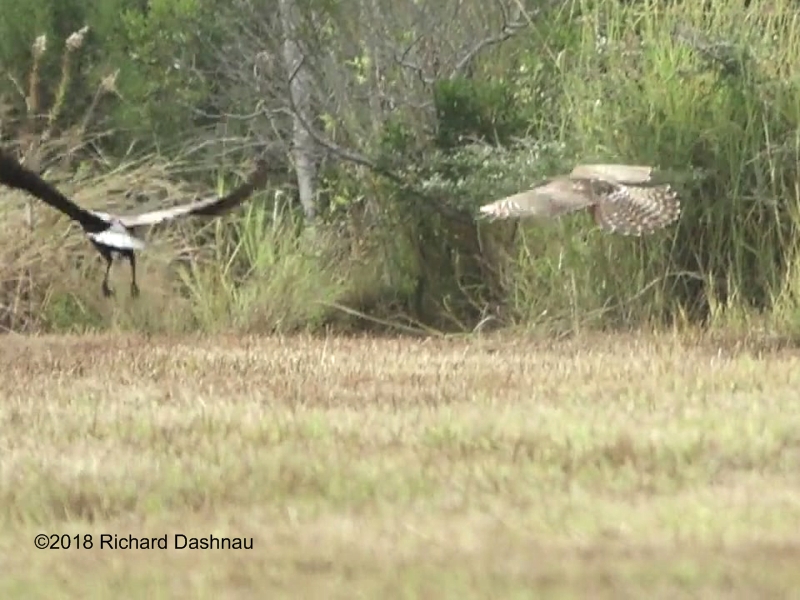
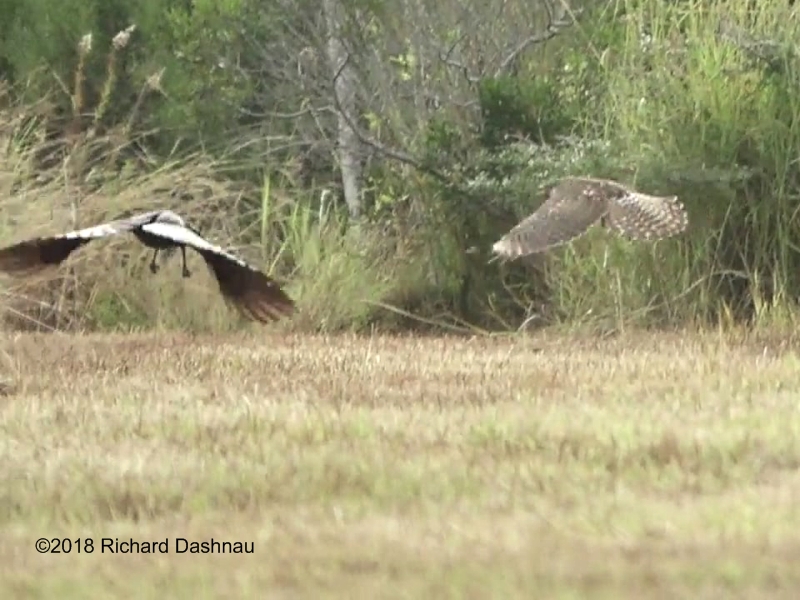
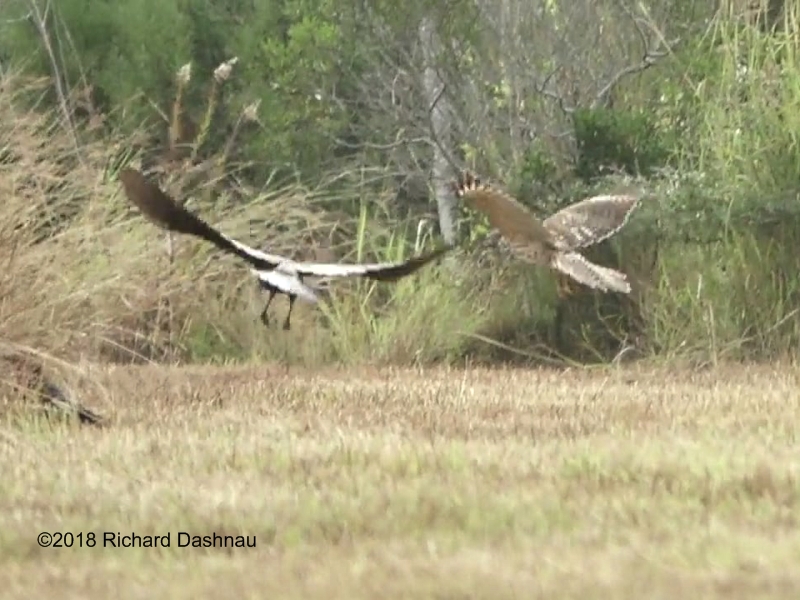
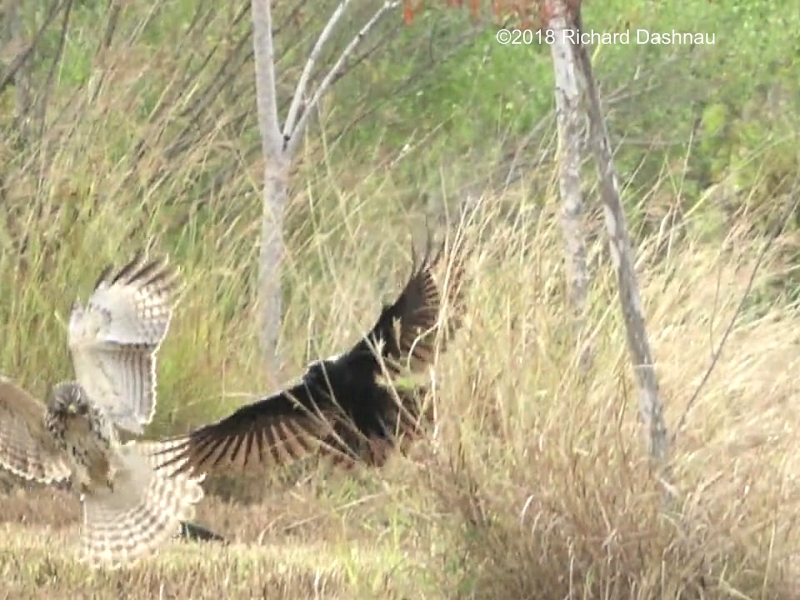
There
was some brief, "non-aggressive" chasing. In the images above, a crow
meets the hawk in the air. They both landed.
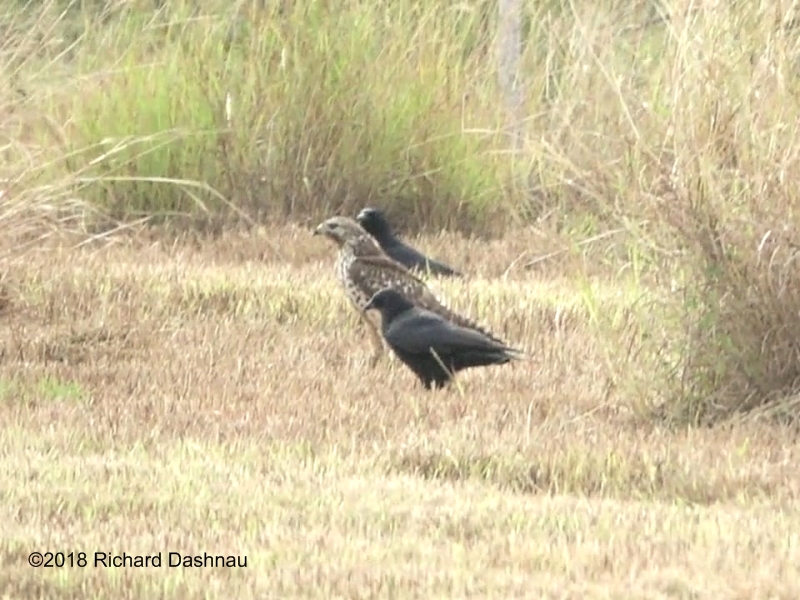
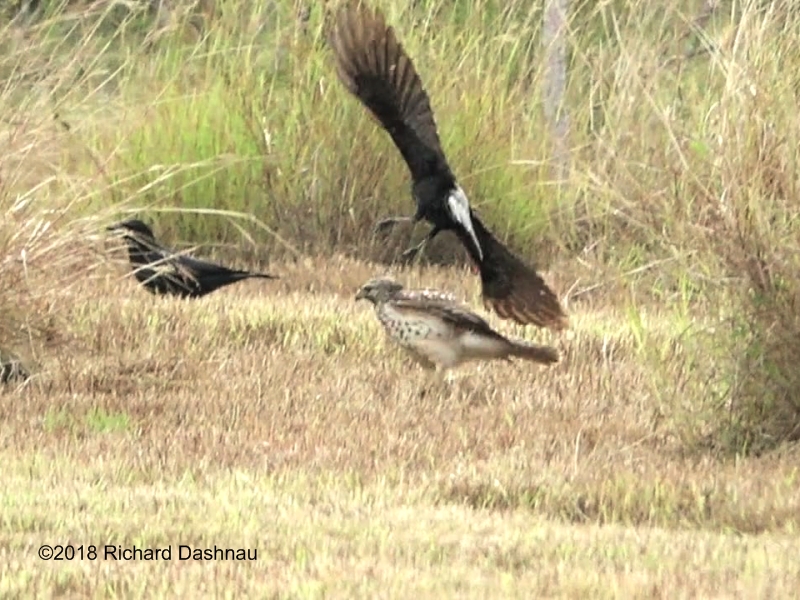
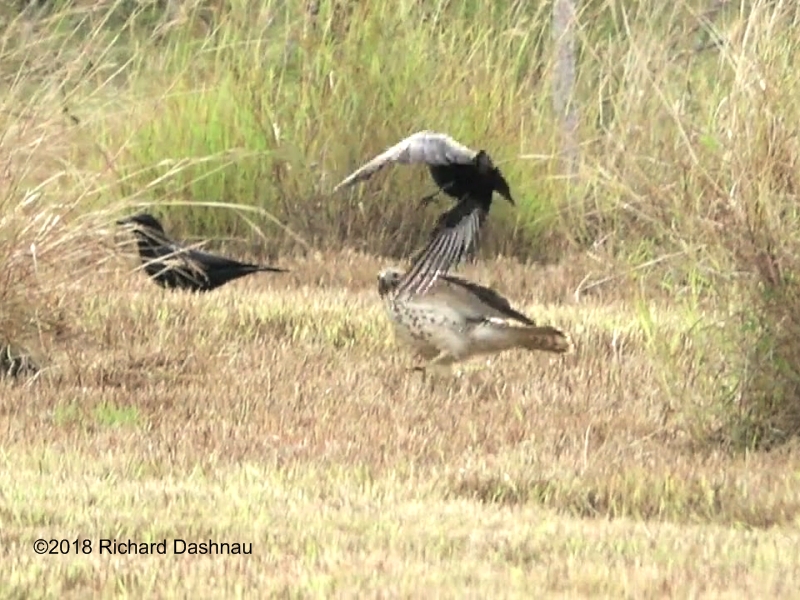
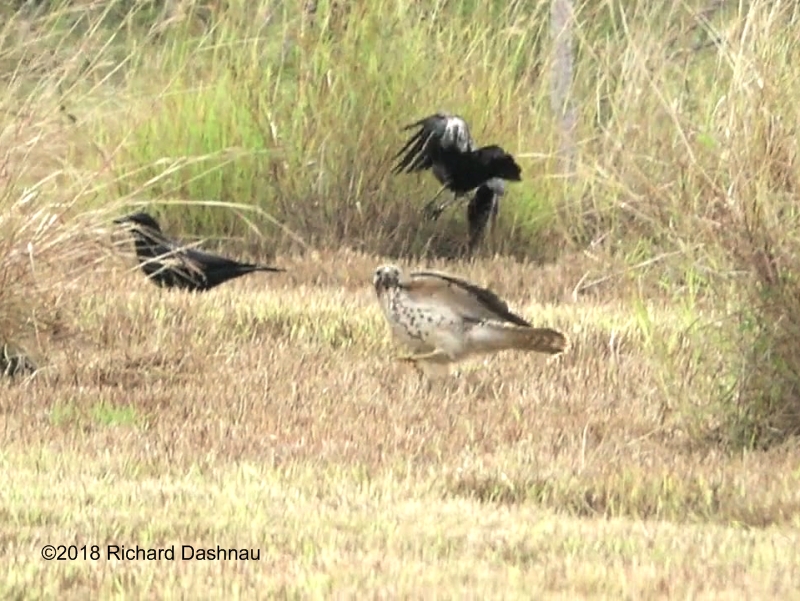
They
stood near each other, crows silent. A
crow makes
one more statement, flies over the hawk; which reacts with raised foot
and wing spread.(3 images above and first below.)
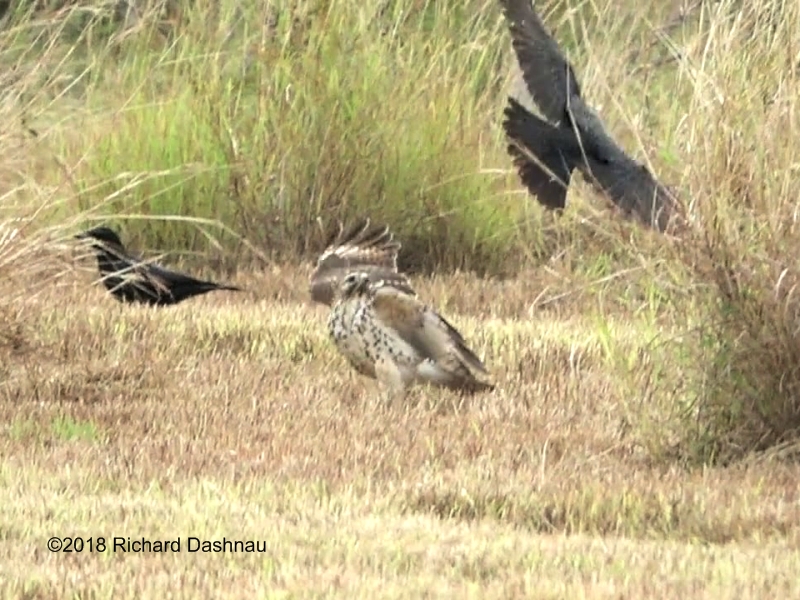
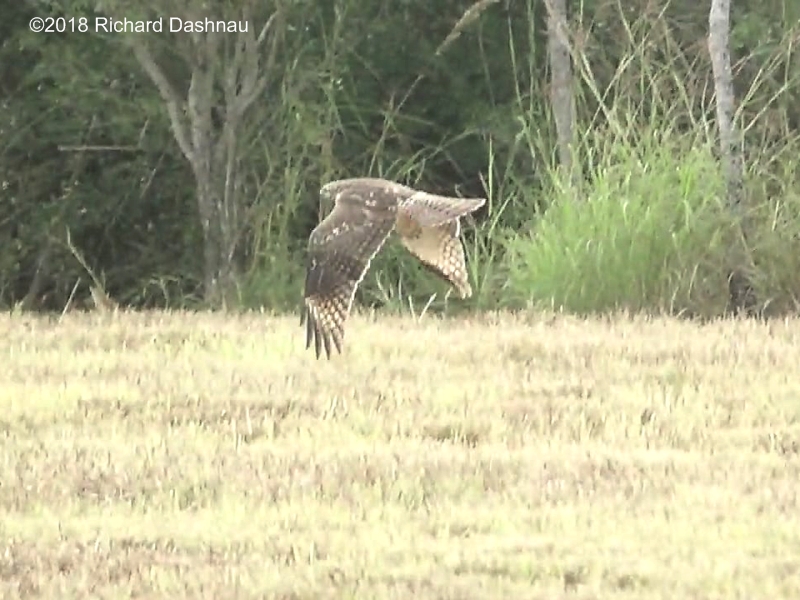
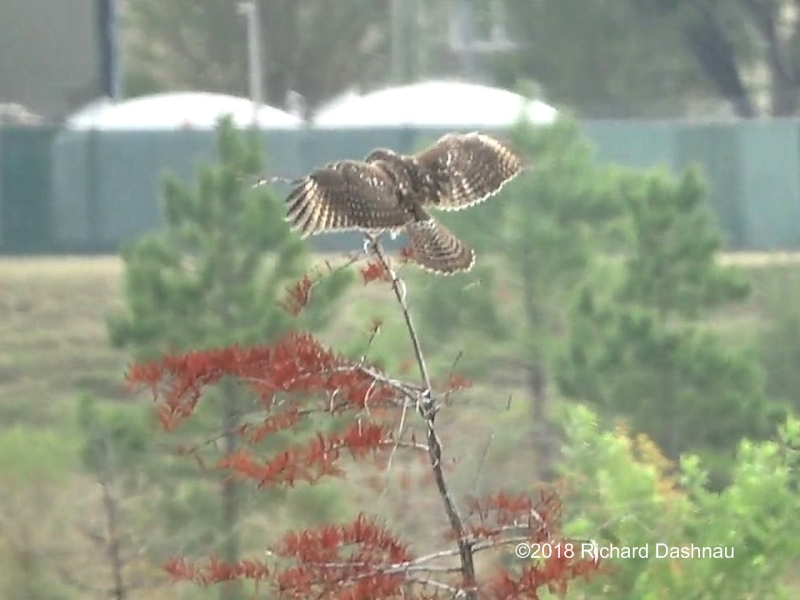
Then,
both species spent time near each other, looking for something in the
grass. I thought this tolerance was odd, considering how
crows normally treat raptors as a threat. Any
interaction seemed to be over ownership of the food resource. The
crows moved off.
The hawk foraged a bit more, then flew up into a
tree.
06/03/2018 Later
that day, in the afternoon, I was near 40 Acre Lake again, but on the
winding sidewalk that goes down to the pier. I heard hawks calling
among the trees, and then
one landed right above ME in one of the
Live Oaks.(HAWK 1). It flew from one tree, to another, then
another; then flew off towards the playground. I found it again
--maybe.
It could have been a different hawk. It was on the grass just
past one of the picnic tables. Through binoculars, I could see that the
hawk was eating something.
When I tried to move a bit closer, the
hawk flew into the trees to the East. I walked into the picnic area,
and found a hawk again. This time it was down near the water
on a
small hump...and eating again (or still). It flew off, but I
just
waited. Another (or the same) hawk appeared and chased off a crow, then
re-entered the trees.
And then another hawk appeared. And another.
So I just stood still and watched as they moved around, and I took a
few more pictures. (HAWK 2,3,4,5.)
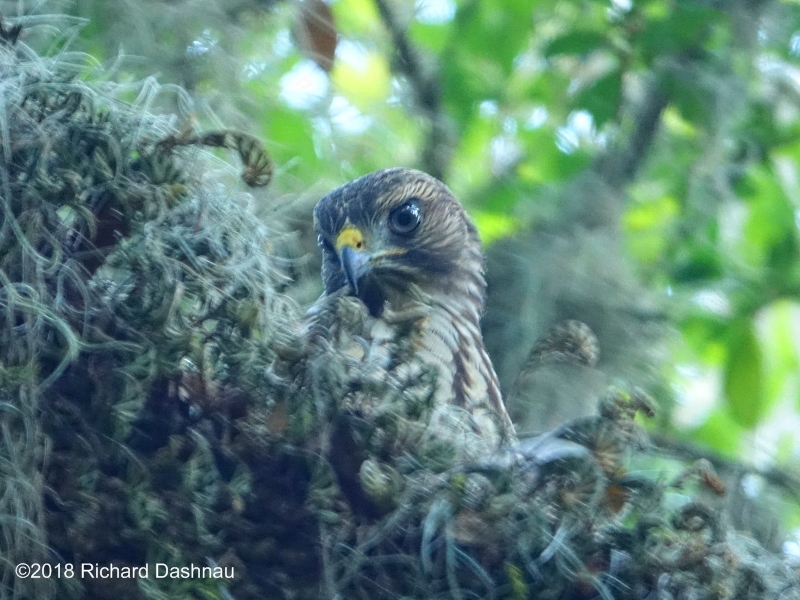
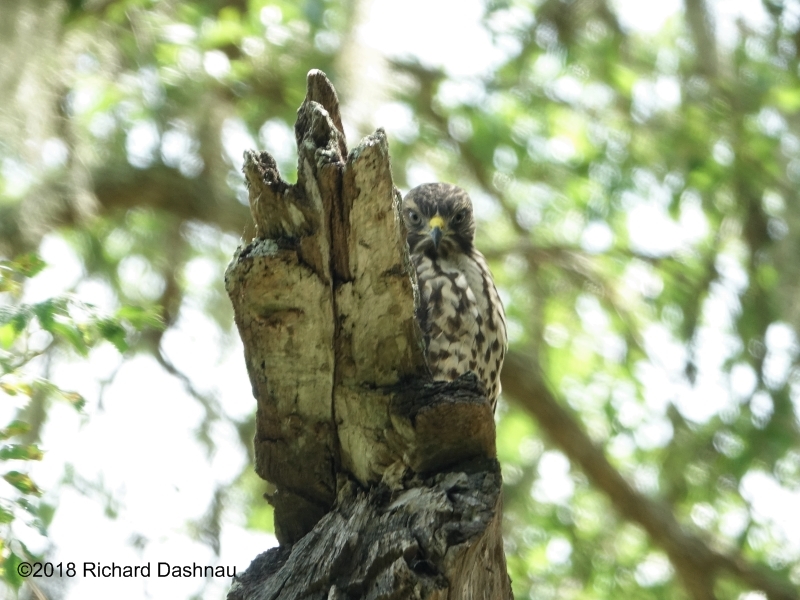
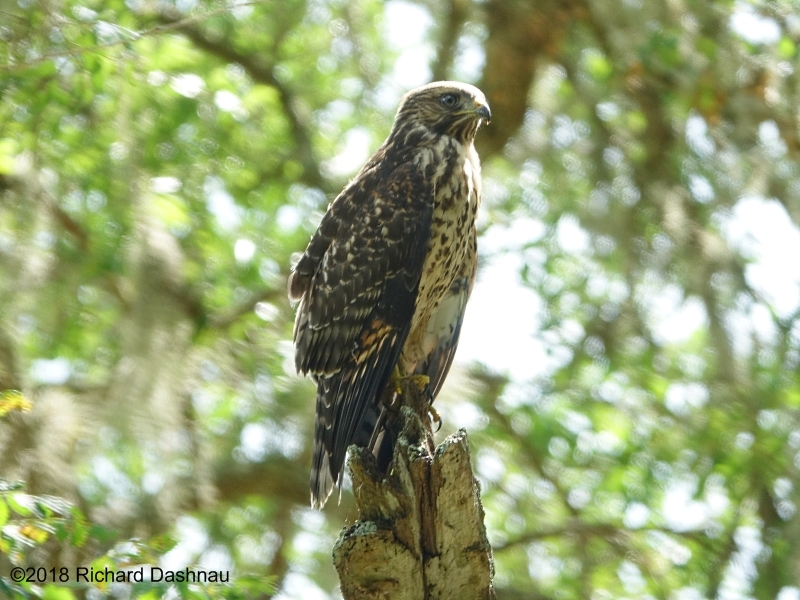
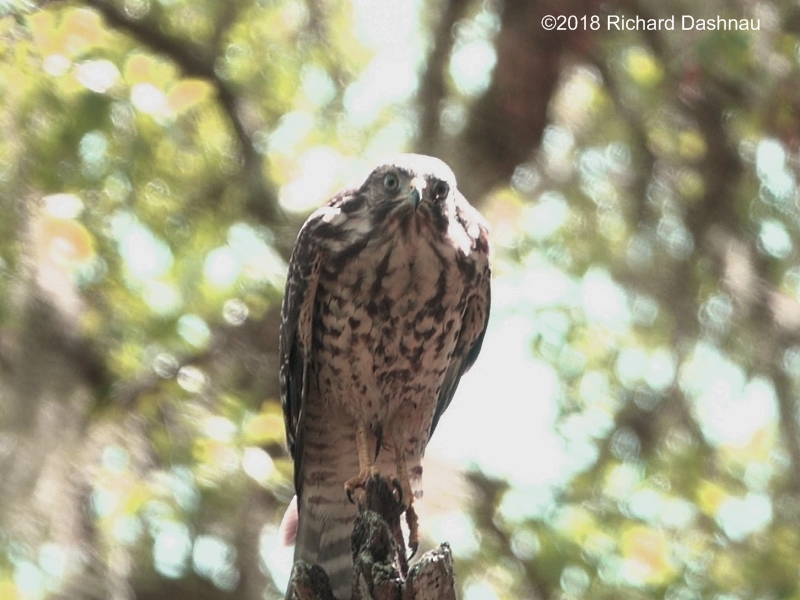
HAWK 1
HAWK 2
HAWK 3
HAWK 4
According
to people more knowledgable than I am, these are juvenile
Red-Shouldered Hawks; possibly 2 or 3 juveniles and one adult. Once,
while one of the hawks
was looking around, I thought things would
get interesting when a squirrel moved along the same branch as the
hawk.(HAWK AND SQUIRREL) As the picture shows, the hawk thought it
was interesting, too. The squirrel turned around and moved
behind the branch before encountering the hawk.
I
followed the hawks until they seemed to gather in the shaded branches
of another Live Oak tree. I couldn't find them all at the same time,
though I could spot
one or two together. I left them to their day.
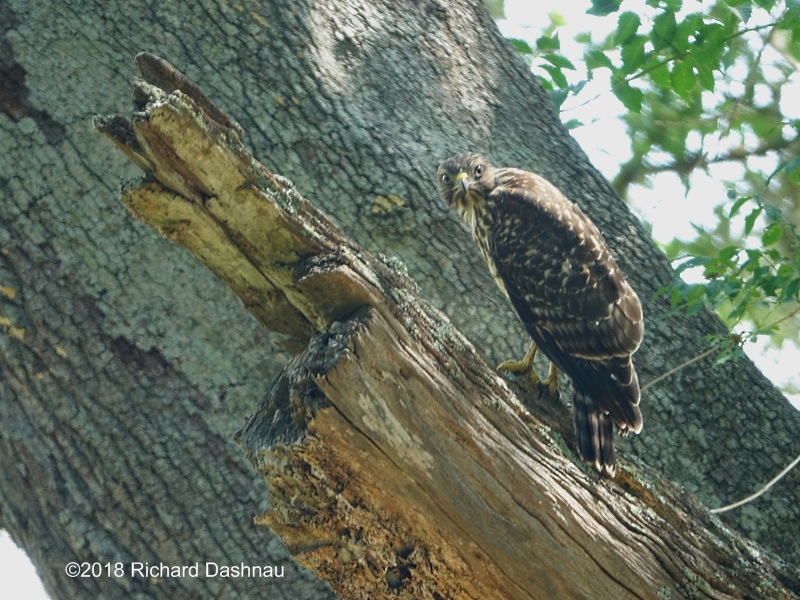
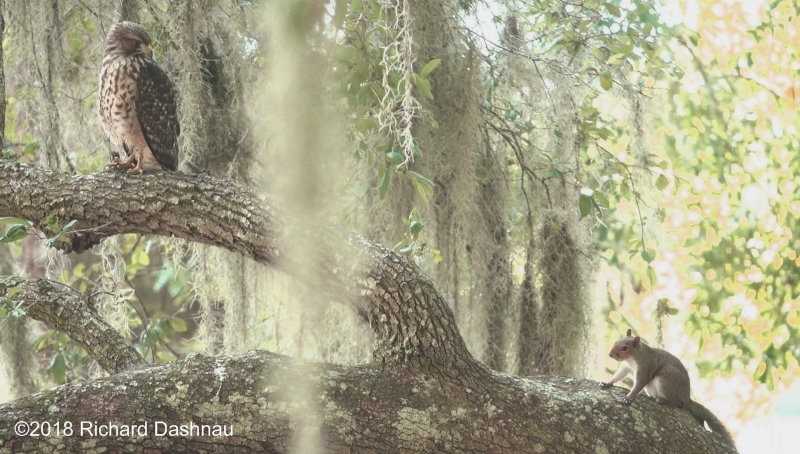
HAWK 5
HAWK
SQUIRREL
07/08/2017
Russ
Pitman park is a small park in Bellaire, Texas. It covers 4 acres. I
had just walked in, and I saw a Cooper's hawk about 20 feet
away,
on a branch about
8 feet above the ground. It flew past me, and
landed on the small waterfall near the new "wetland" area. This was
only about 20 yards away, so I stopped moving, and watched
the
hawk as it moved on the waterfall. After a few minutes, it was joined
by another hawk. and they took turns bathing in the water. After about
10 minutes, one of the hawks
flew towards me, and landed on a
branch. Then it took off and flew right past me (about 10 feet from
me!). Meanwhile, the other hawk remained in the water. 5 minutes later,
if also flew towards me, and landed on the same branch. I stood and
watched it for about 20 minutes-waiting for it to take off. It finally
did, and I could move along the trail.
It was wonderful to be so close to the hawks for 30 minutes.
The images below are photos that I took during this bath.
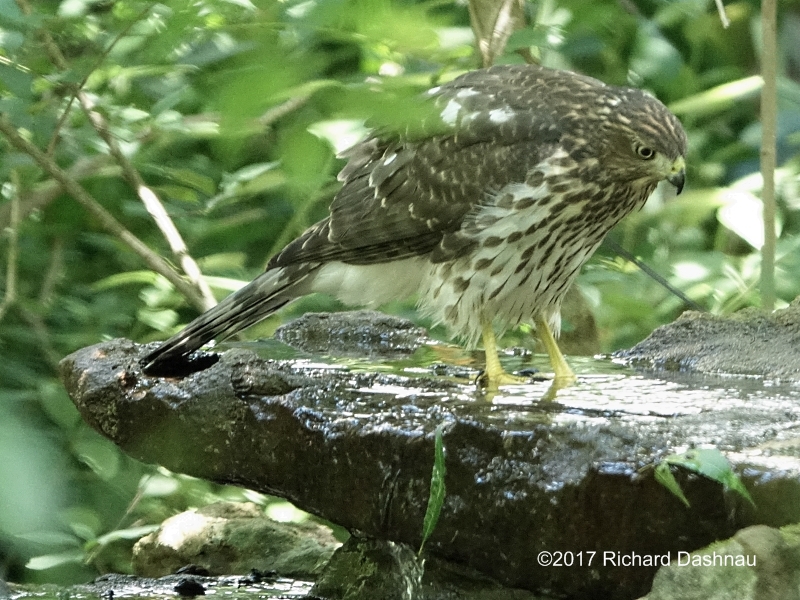
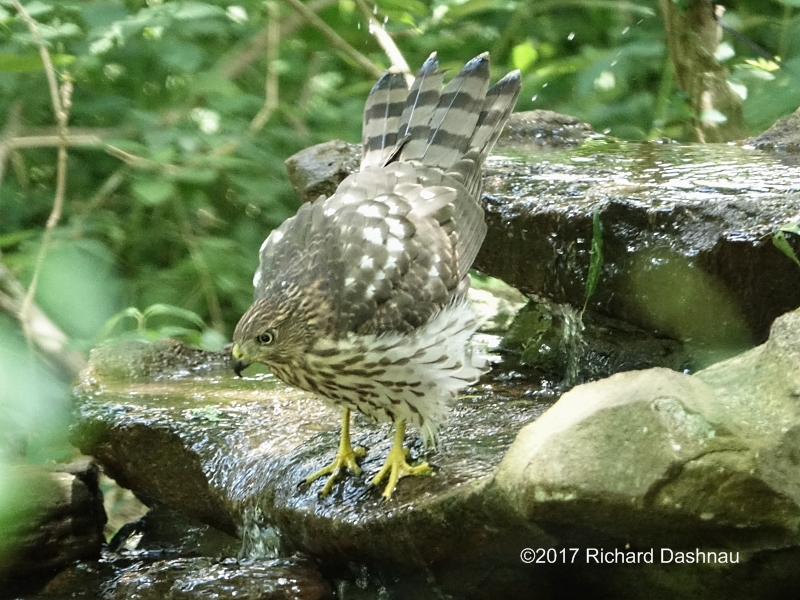
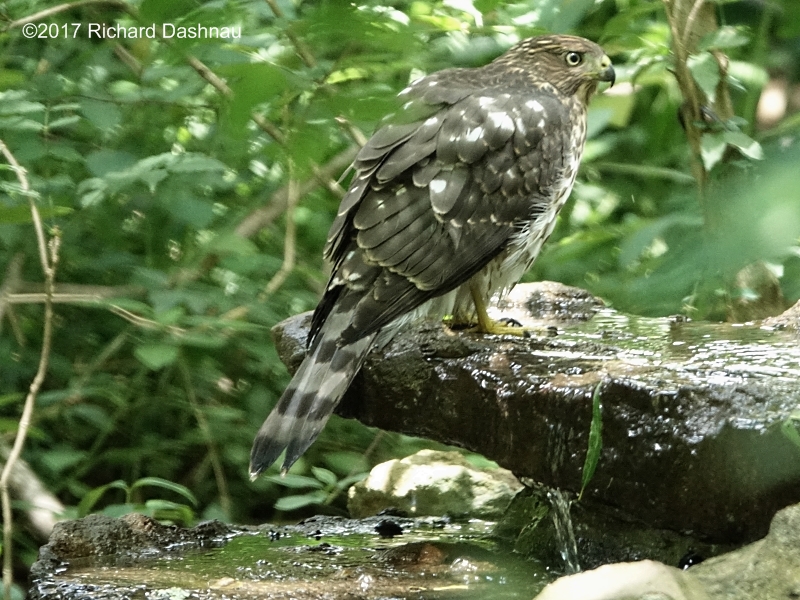
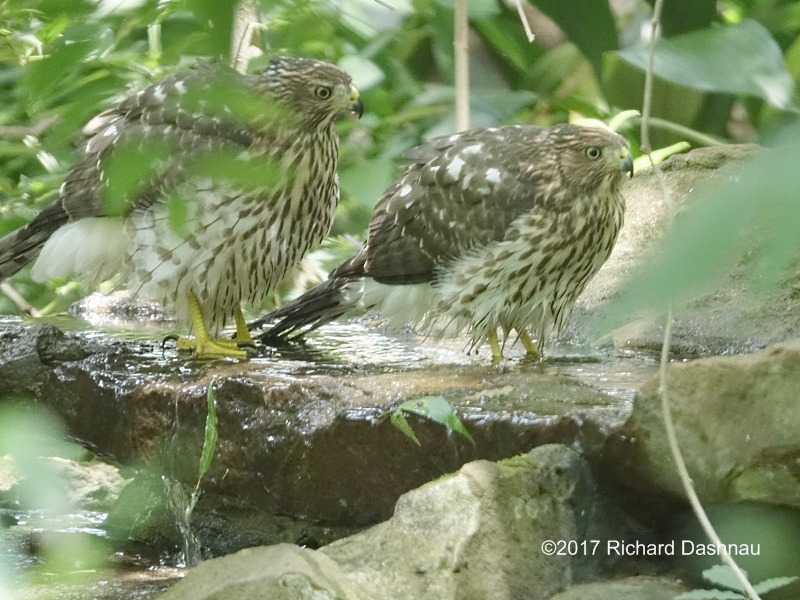
Not
long after, I found two Cooper's hawks higher in a tree...along with 2
*more* hawks. So, I walked around the trails, to see how they've
been improved and watched the
4 hawks from different angles. I also
heard them calling to each other. I was able to enjoy the presence of
the hawks for about about an hour and a half. I thought it was great.
The
two images below are two more photos taken around this time. The image
below right shows 3 of
the hawks in a group. One of them had just flown down to the "pocket
prairie" area. An intern at
the park told me that 2 of the
immature Cooper's hawks had grown from a nest in the park: while 2 more
immature hawks apparently came from somewhere else and settled in
the park.
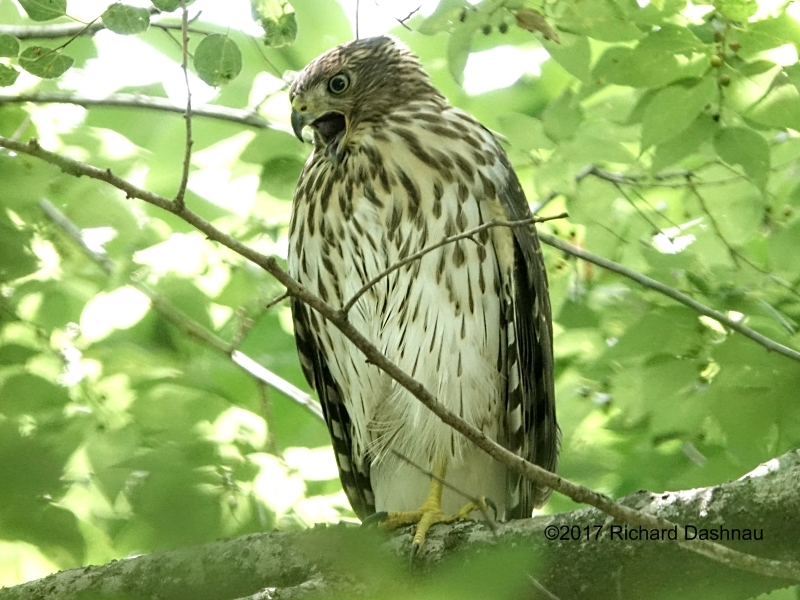
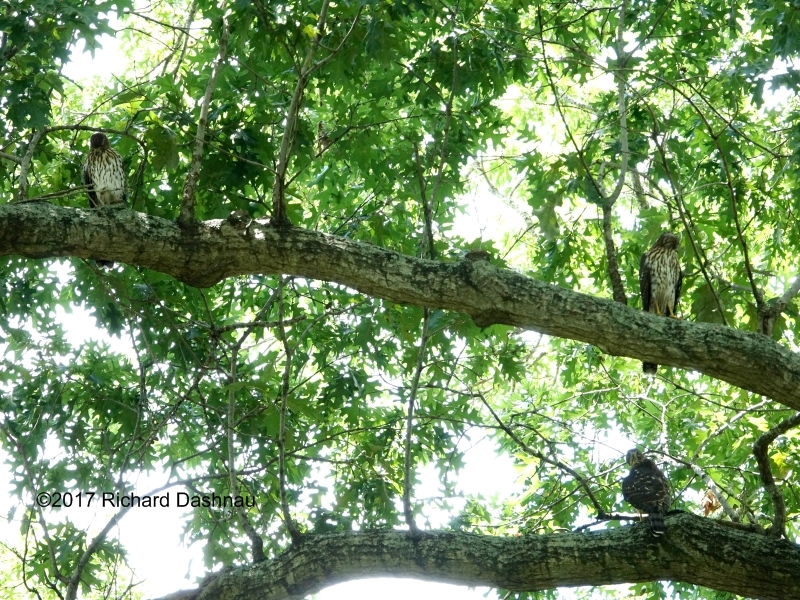
The images below are framegrabs from the video clip that can
be seen here. The video clip is about 5 minutes long and
shows the Cooper's hawks bathing, and then
one flying out of the pool, the off a branch later. The last two events
were recorded as high-speed video.
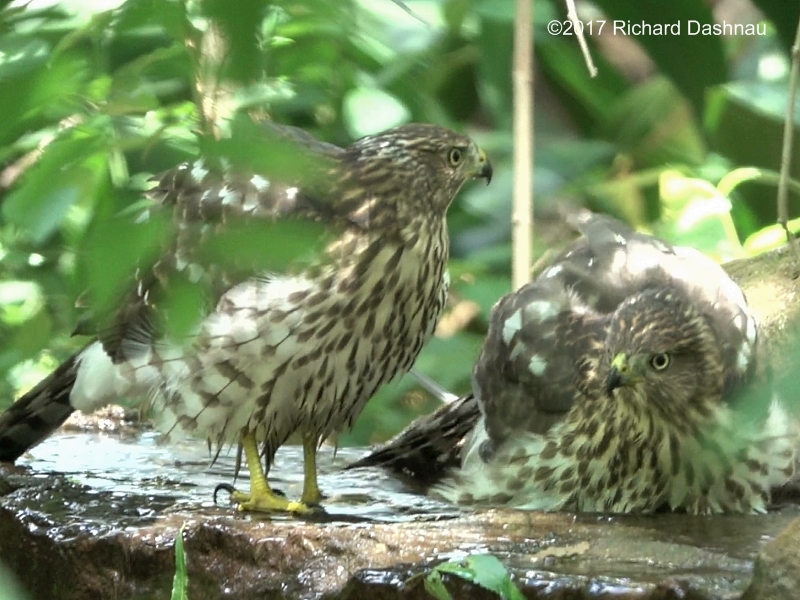
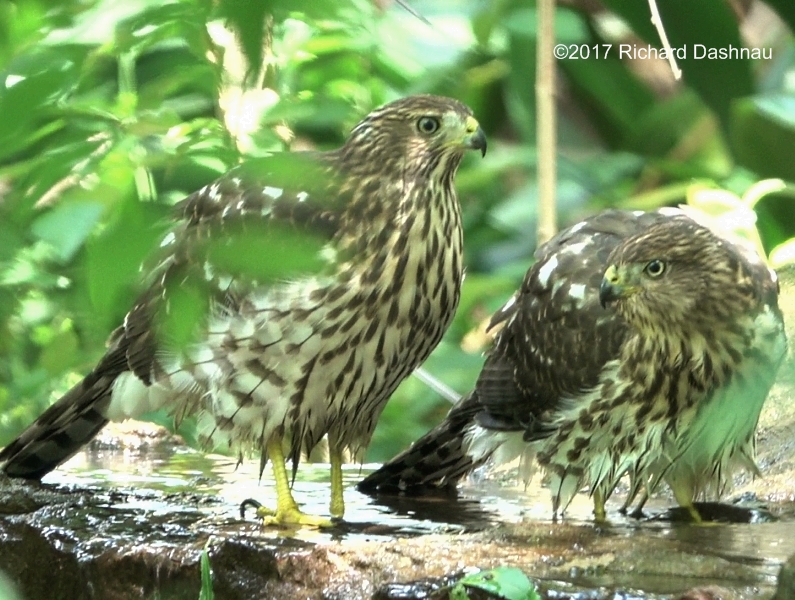
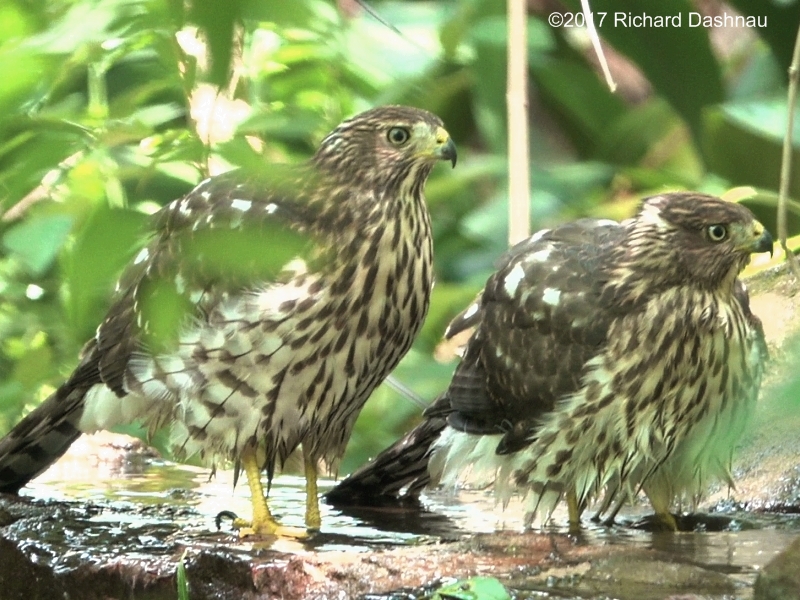
10/05/2016
While
walking Piper today, I heard a squawk sound above and behind me. I
thought it sounded like a hawk, so I turned around.I saw a hawk land on
the grass in front of one of the apartment
buildings. It squatted
against the grass with flattened spread wings, and was about
25
yards from me. I didn't want to scare it (especially since I had Piper
on a leash with me), so I tried to take a couple
pictures with my
cellphone without moving any closer. We walked to the end of the
street, and then crossed and came back. When I was across the street
from the hawk, I stopped and watched. I still
couldn't tell what
it was up to. Someone else with a dog came down the opposite sidewalk
and when they got close to the hawk, it flew straight up into a tree.
After a briefbit of movement, it flew to another
tree. When it did, I could see something hanging from the hawk. It
looked like it could be a squirrel's tail.
I
continued back to my apartment, where I fed Piper. Then I
grabbed
my camera and walked back to the tree where I'd last seen the hawk.
(about 300 steps from my apartment) I found the
hawk! I had
to
focus through the leaves and branches to get pictures of the
hawk as it ate. It was hard to focus during the photos and larger-frame
video. Only a few of those photos were clear. Some of them
are shown directly below. This appears to be a juvenile Cooper's Hawk
(accipiter cooperii).
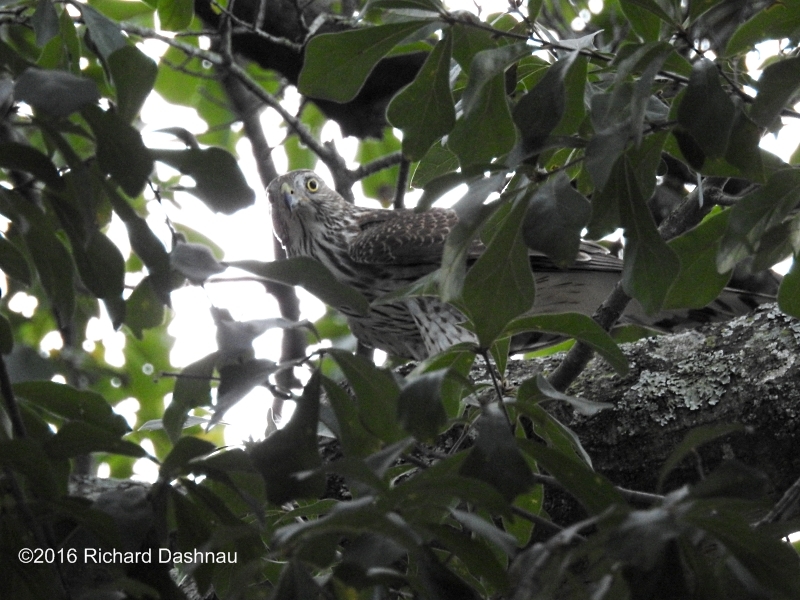
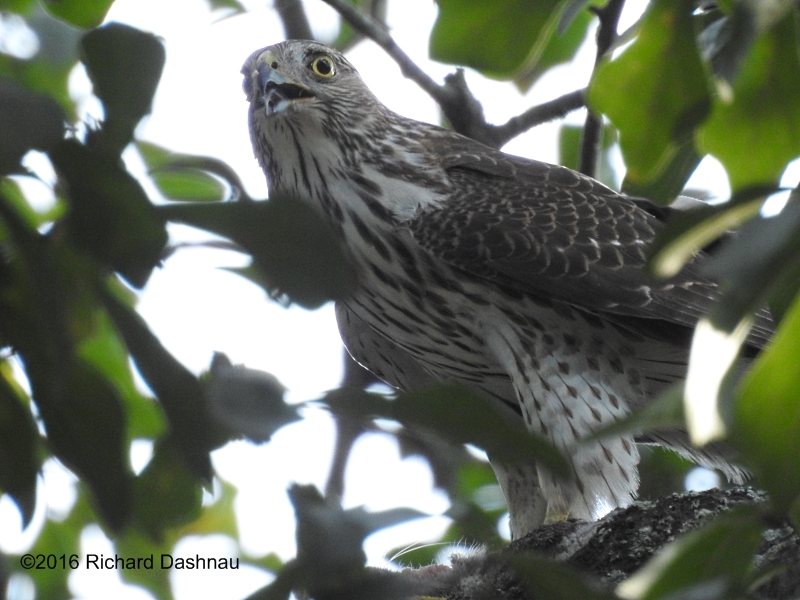
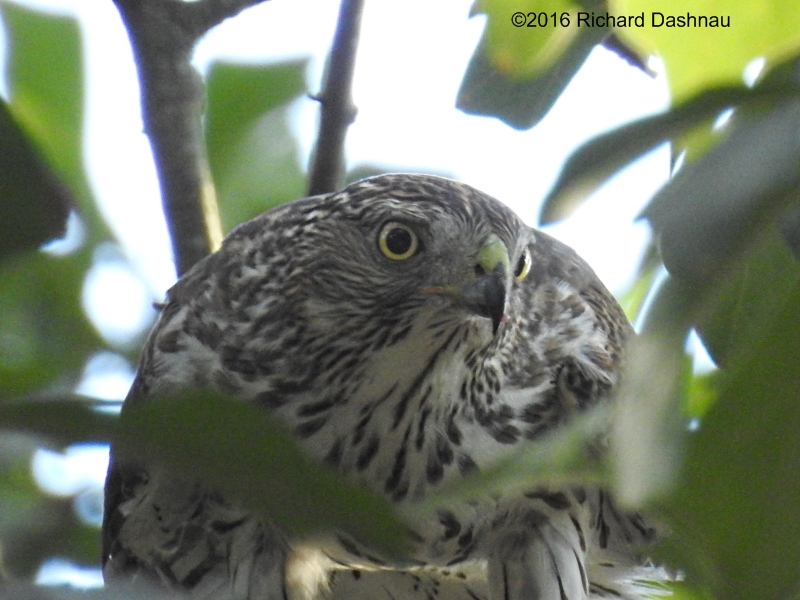
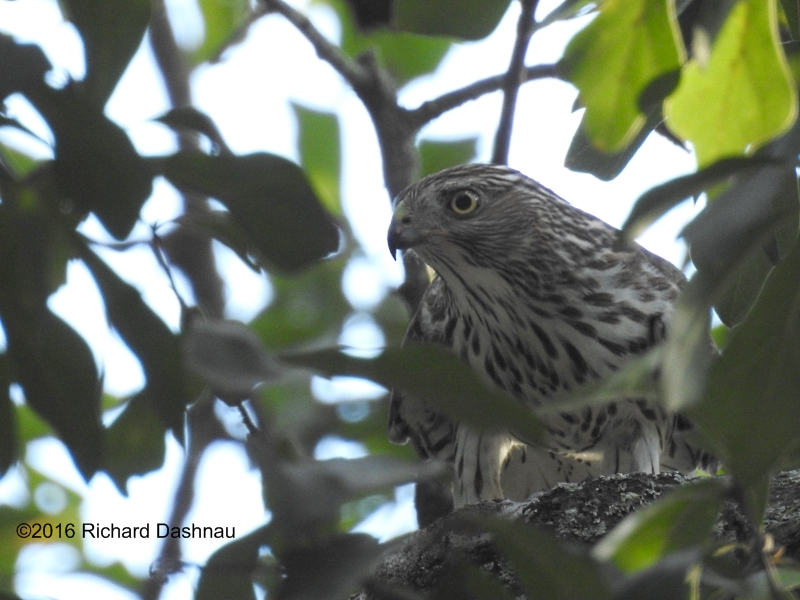
I
found that the smaller resolution (640 x 480)/higher frame-rate
(120fps) video worked better,
so I shot mostly in that configuration. I got some interesting
video. I've edited various clips together (including
a few from my cell phone) in the video right
here. The
video
does show the deceased squirrel a few times, but is not as "graphic" as
it could have been. I've included most of the high speed footage
because I
think it's a great view of the hawk. The
images below are frame grabs from some of the clips. While I
was
filming the hawk, I could hear a nearby squirrel calling. I think the
sound is an "alarm" call.
As the hawk worked on the carcass, a squirrel began working its away
among the branches. It was moving towards
the hawk! The hawk noticed the squirrel, but continued
eating. Finally, the
squirrel
made its way to the same large branch the hawk was standing on. I
decided to try to film the squirrel, and while I was trying to focus on
it, the hawk flew away. I couldn't tell which
direction the hawk
flew off to, and so I lost it. I also couldn't tell if it had carried
off the carcass. So that was the end of my observation.
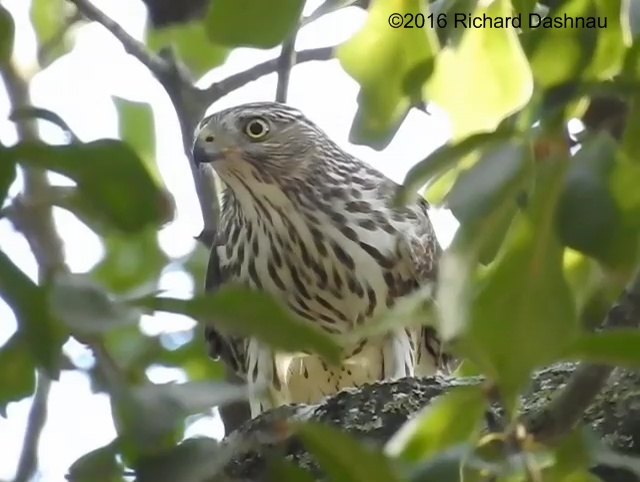
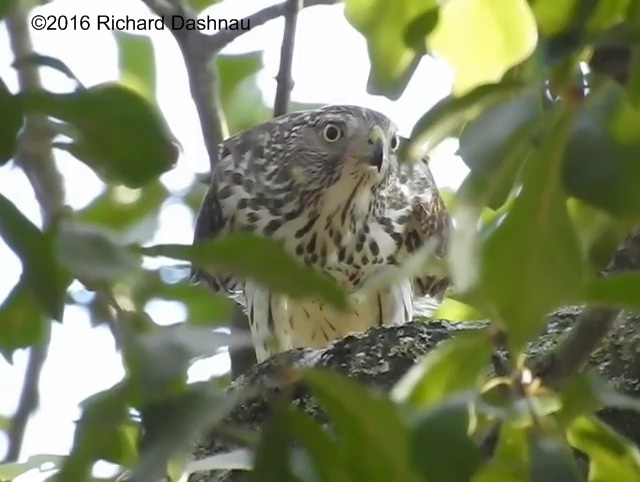
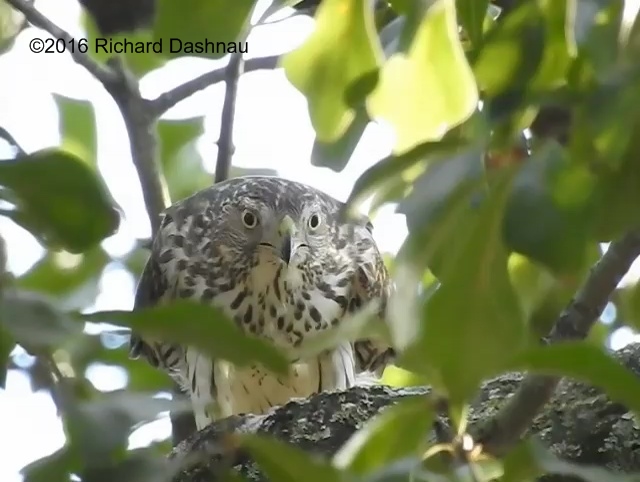
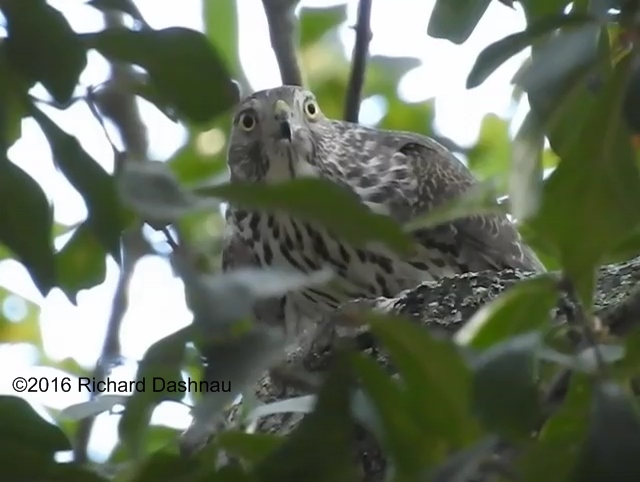
Because
of the clarity of the video, I could see the hawk swallowing a few
small portions of meat. I tried to find some descriptionof the cutting
mechanics of prey processing in Cooper's hawks,
but didn't find anything specific. However, I found these two articles:
1)"Predatory Functional Morphology in Raptors: Interdigital Variation
in Talon Size Is Related to Prey Restraint and
Immobilisation Technique" by Denver W. Fowler, Elizabeth A. Freedman,
John B. Scannella (link
); and
2)
"In vivo bite and grip forces, morphology and prey-killing behavior of
North American accipiters (Accipitridae) and falcons (Falconidae)" by
Diego Sustaita,and Fritz Hertel. (link)
From these two articles I learned the following:
Birds
of prey (raptors) have been classified into different groups:
Accipitridae (hawks, kites and eagles); Falconidae
(Falcons);Pandionidae (Osprey) and Strigiformes (Owls). There
are
different
features that help identify these groups. The studies
focus on how the talons are different between the groups of raptors,
and how these differences reflect the different ways the talons are
used; and
the measured differences in forces generated by the beaks and
talons of falcons and hawks.
Generally,
falcons strike their prey in the air at high speed, and then further
disable or kill it by using their beak to do major damage to spinal
nerves. Hawks, on the other hand, usually ambush from
closer
cover
and therefore hit their prey at lower velocity. Hawks then use their
feet to immobilize or kill their prey. If the prey is small enough, it
is killed by suffocation caused by the hawk squeezing
hard enough
--with
its feet(or a foot)--to prevent the lungs from working. If the prey is
too large for this, then it is held tightly by the talons, and either
suffocated by the bird pressing down on it or-if the
prey is
immobilized
enough-the hawk will start eating while the prey is still alive, and
the resulting trauma causes death. Neither of these studies mentioned
piercing internal organs with the talons.
These two studies seem
to indicate that the configuration of the talons ofthe various types of
raptors has a strong relationship to the way their prey is subdued. For
example osprey and bald eagles
both have diets with a high
proportion of fish. Their talons (and they are in different groups) are
nearly the same length on all their toes; and are heavily
curved...wonderful for keeping a grip on fish
snatched from the water.
Osprey
have a further advantage (that eagles do not) in that they can
rotate their 4th toe backwards, so that ospreys can hold prey with 2
talons on each side of the prey. Compared to these
two
groups,
owls have relatively short, less-curved talons. But the talons are
of equal length on all toes; which are proportionately
shorter
than the other raptors. Owls can also rotate their 4th toe to face
the
rear. This,
and the shorter toes, allow for greater
leverage--which allows owls to kill their prey by crushing with their
feet, possibly stabbing internal organs with the straighter talons,
crushing key
bones or biting with their beak. Hawks
have
strong toes with long talons, but the talons on the 1st and 2nd toes
are much longer than the third and 4th. The two pictures below show the
talons of a
stuffed hawk on display at the Nature Center in Brazos
Bend State Park. I believe that speciman is a Red Tail
Hawk (Buteo
jamaicensis), but it still shows the difference in talon length. The
talons
on toes 1 and 2 are much longer!
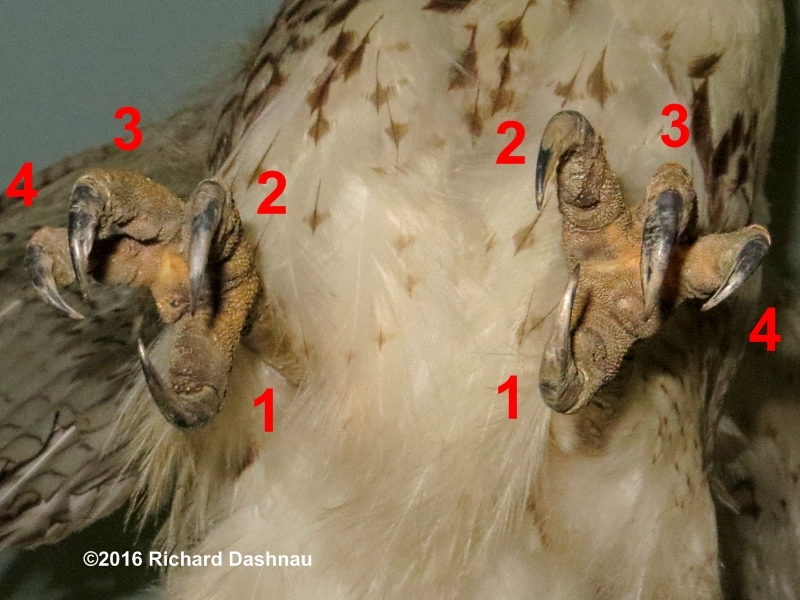
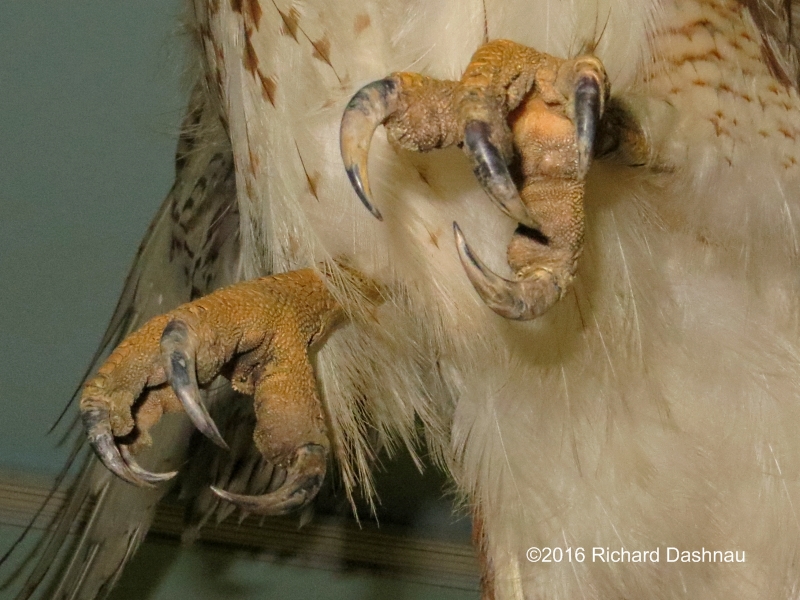
Their
grip is also powerful, as
mentioned above. Hawks will also hold secure prey by holding it down
with the 2nd toes of both feet--using the other 6 toes to steady
themselves against the surface they
are standing on. By comparison,
falcons have smaller talons, and even lesser-developed toes, but they
have stronger bites, and some even have features on their beak
that they can use to sever spinal
cords, or do similar damage.After
reading the articles, I think that when I first saw the Cooper's hawk,
it had just caught the squirrel--and was holding it down until it
stopped moving. That explained why
the hawk at risk on the grass for so
long (long enough for me to go to the end of the street, and come back
down the other side.)
7/02/2016
and 7/04/2016 Since
BBSP has been closed I thought I'd be visiting other places...but some
issues came up which prevented such thing. When I finally got some free
weekend time, I
visited Russ Pitman Discovery Center a few times. I
usually go there to watch the Anoles. Both Brown (or Cuban) Anoles (A.
sagrei) and Green (or Carolina) Anoles live there. While I was there,
I
was told that Cooper's Hawks had nested on the property, and I might be
able to see the young ones flying around.
And...I did. I enjoyed
watching the hawks so much, I went back a few days later, to look for
them (and for Anoles). While the Cooper's Hawks were active,
it
was hard to watch them for very long,
since they moved among the leaves
and branches until briefly showing in the air to get among
other
leaves and branches. But I did get some pictures. I caught
sight
of one as it rested on a branch
over the path. While I watched, it
seemed to lie down so its breast was against the bark of the tree. I
don't know if it was resting, or trying to cool. For other pictures, I
had to
try to shoot pictures
through gaps in the leaves.
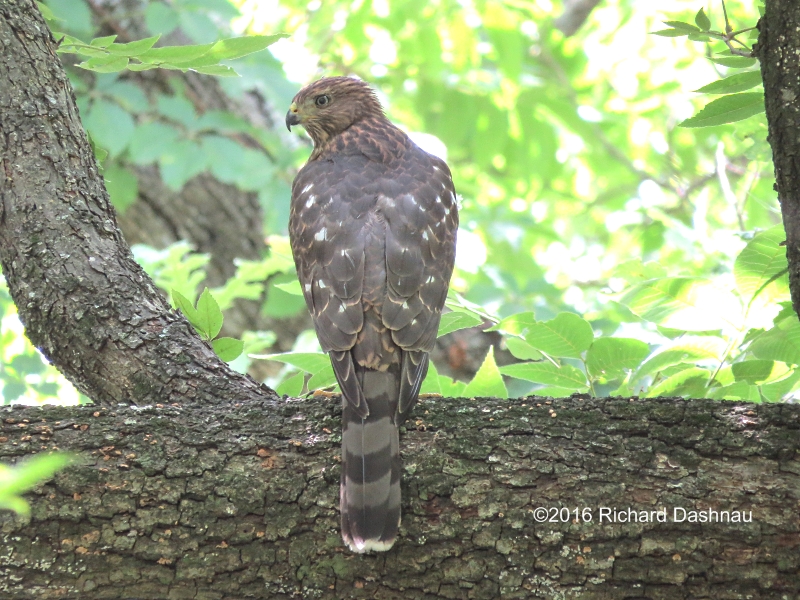
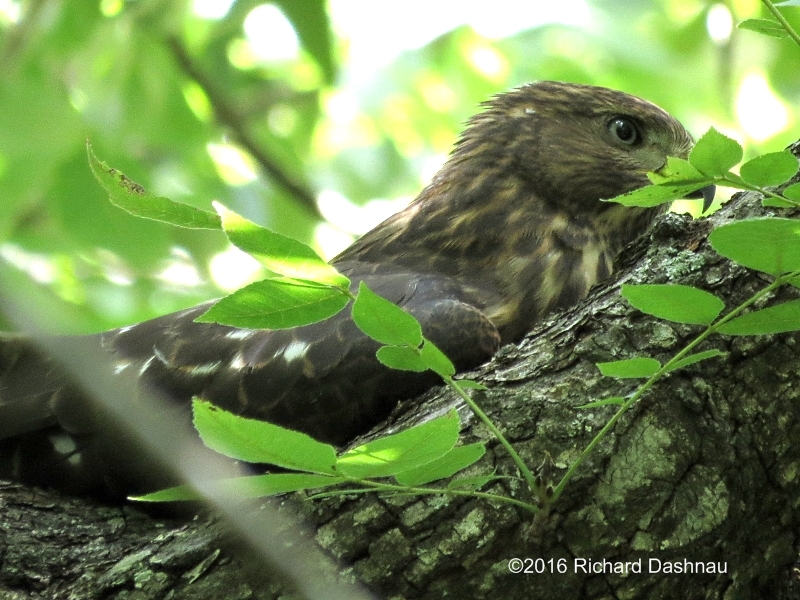
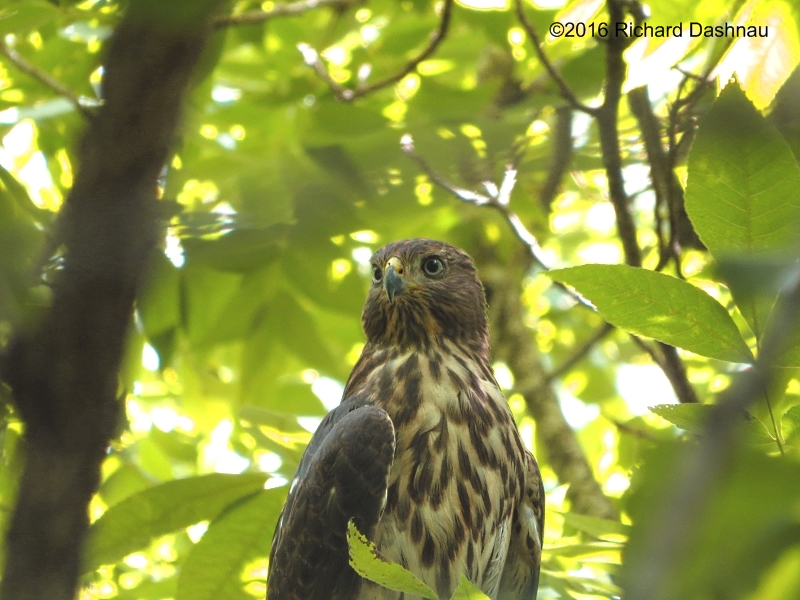
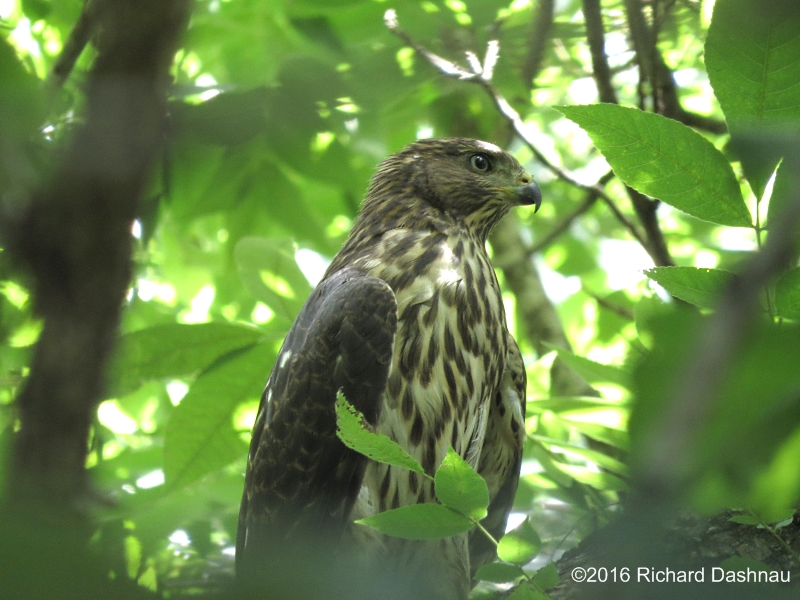
Posing in the open
Lying
down on the branch?
Among
the branches
Still
among the branches
Young
Cooper's Hawks (Accipiter cooperii) and Sharpshinned Hawks (Accipiter
striatus) are very similar. Staff at Russ Pitman told me these were
Coooper's Hawks. According to my
copy of The Sibley Field Guide to
Birds (1st edition), page 97)) Juvenile Cooper's Hawks have thin dark
streaks on their breast while juvenile Sharpshinned Hawks have coarse
brown
streaks...and many other attributes that can be recognized by
experienced birders. I am not one of those.
While
I watched, one of the hawks flew down to stalk close to the ground. As
I slowly and quietly tried to move to where I could see it, I noticed another
hawk higher in a tree--watching
the
hawk near the ground. I could only watch and wonder what would happen
next. But...nothing happened before other park workers came
by
and distracted the hawks.
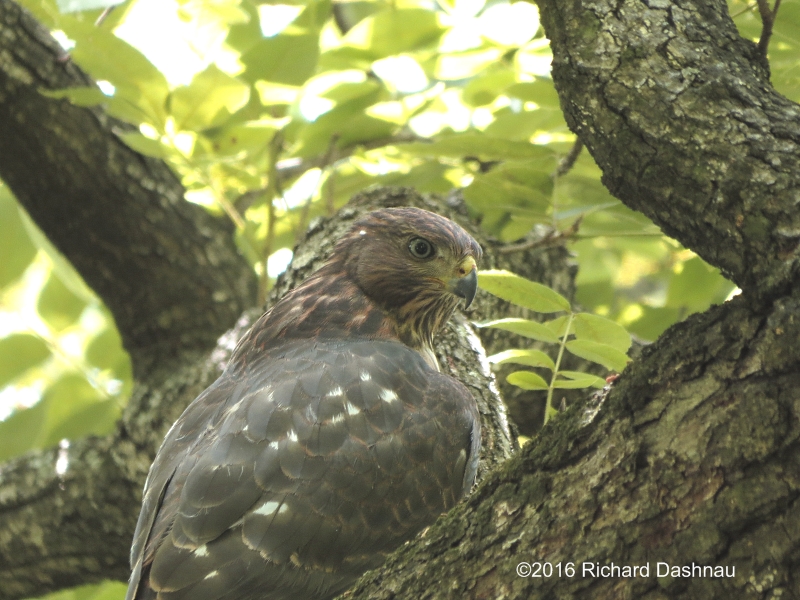
Under cover again.
When
I returned on July 4th, the Cooper's Hawks were still busy, but hardly
ever rested where I could get a good picture. One of them seemed to be
harassing-or hunting-a Bluejay. The Bluejay was
not calling, but
seemed to be hiding and fleeing. As it jumped or made short
flights to covered branches; the pursuing hawk would appear, following
nearly the same course--plunging into the leaves and
climbing among them. I finally lost sight of the chase, so I didn't see
what happened next.
March
09, 2014 I'd
missed the previous weekend at the park because I moved to a new
apartment. This was the first weekend in almost 2 months that I was
able to relax (no more packing/unpacking/moving),
and BBSP gave me a
couple of treats. I was walking on the North side of the 40
Acre
Lake Trail at about 8:45, when I noticed a pair of Red Shouldered Hawks
in a tree over the trail. I noticed them just before
they took off
(this happens to me often). But, they only flew a few yards, and landed
on the trail, near a pile of dark material that was in the center of
the path. I moved slowly towards the pile, and the Hawks. One
took off,
and flew past me on my left, and went West. The other one flew up into
a tree near the trail, and stayed there. I got a little closer,
when,
the Hawk flew back down *towards me* and landed on the trial
near the
pile. By then, I could see that it was a pile of water hyacinth. I took
one more step, then watched the hawk through the camera. The hawked
hopped into the grass, where it stared intently at something
there. I
started shooting high-speed video. The hawk seemed to be grabbing at
something with its talon. Finally, it grabbed, then took off and landed
in a tree directly above the trail. There, it started eating
whatever
it had caught. I shot through the camera, hoping to be able to identify
the prey. The hawk finally took off and flew West at about 8:54, going
the same way that the other hawk had. Some of the attached
images are
screengrabs from the video. Review of the video revealed that the hawk
had pulled a live crawfish from the grass!
The pictures below are
all screengrabs from the video clips I shot. Since I was using full
digital zoom for the Eagle, the still images are very "fuzzy". But the
video isn't bad. I've edited the clips into a single file.
The edited video is here: mp4
format
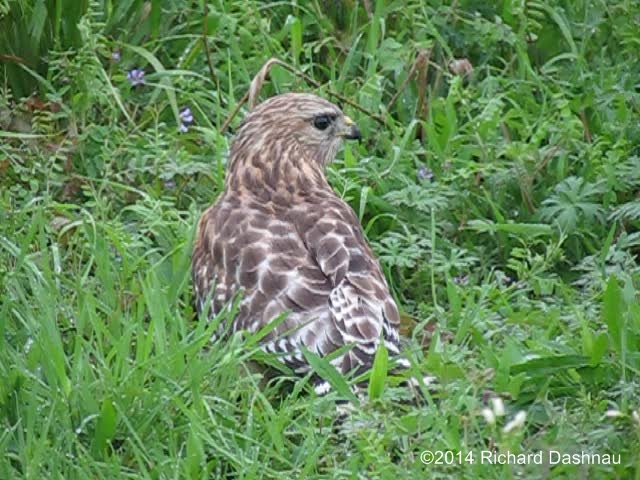
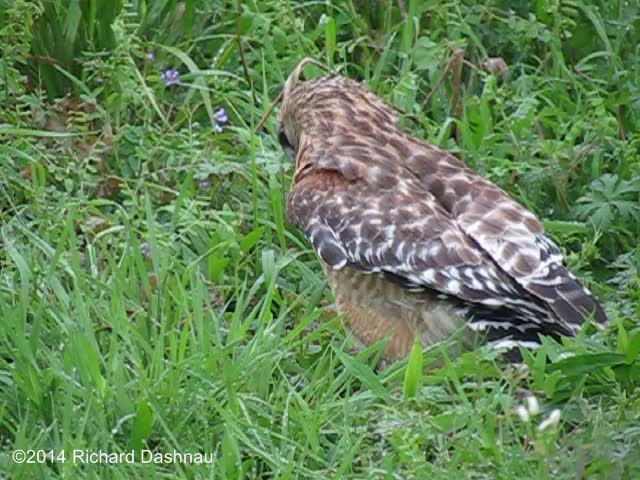
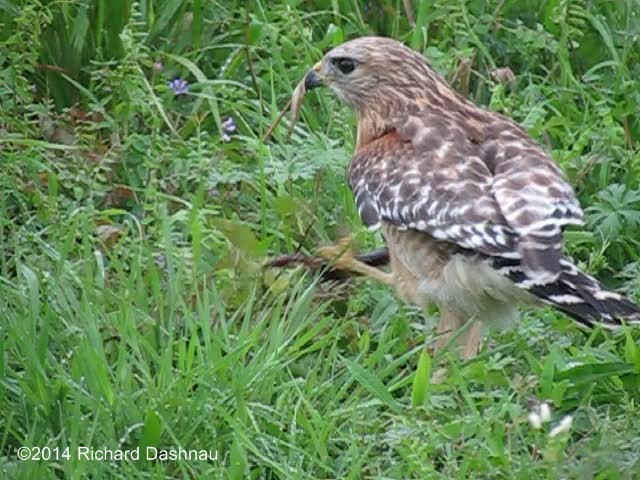
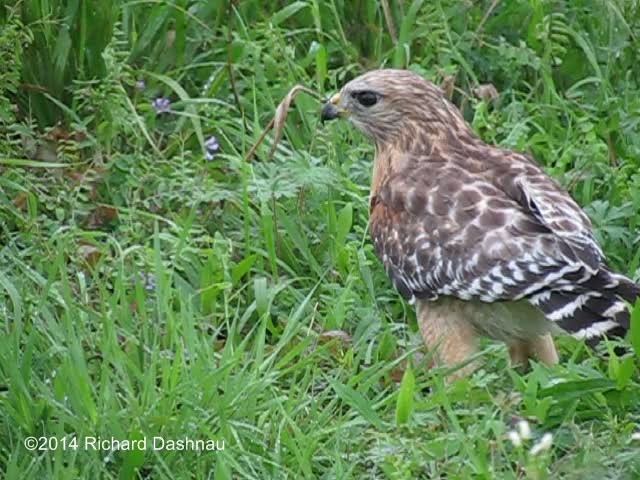
I
continued walking on the North side of the 40 Acre Lake trail, heading
East, towards the Observation Tower. At about 8:57am (just a few
minutes after the hawk had flown away), I noticed a large bird
on
top
of a broken tree near the Observation Tower. The tree was on
the East
side of the Trail, South of the tower. I was about 200 yards away from
the bird in the tree. When I looked through my binoculars,
I could see
that it was a Bald Eagle! I quickly changed the settings on my camera,
and used full zoom to look closer at the Eagle. I started shooting
video. The Eagle was eating...something, but there was
no way I could
tell what it was. I stopped filming, and walked about 20 steps down the
trail, hoping that I'd get be able to eventually get closer. When I
filmed again, the Eagle had stopped eating, but I shot
some video
anyway--along with a zoom shot to give some sense of how far away I was.
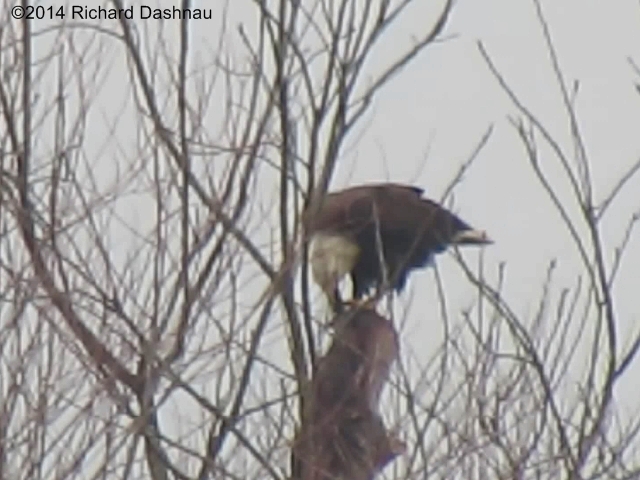
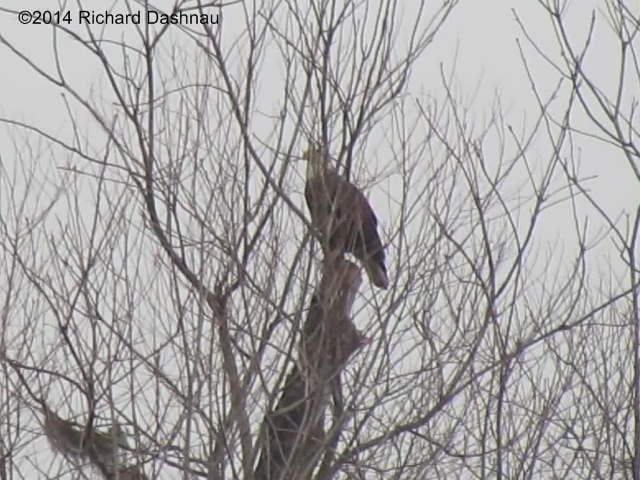
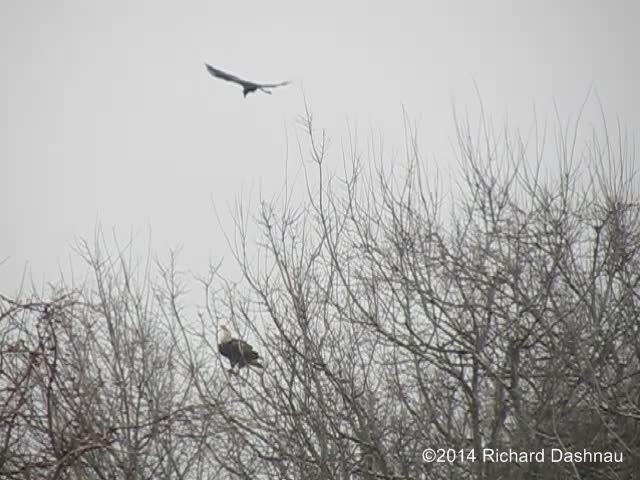
I
took a few more steps, and the Eagle took off--still over 100 yards
away. However, it looked like it flew further East on the Spillway
Trail, so I hurried over to the Observation
Tower. When I got there, I
could see that the Eagle had landed in a tree about 100 yards East of
the tower, right near the trail.
So
I quietly climbed to the top of
the tower, and watched the Eagle. It was just below the top of the
tree, so my view of it was partially obscured by branches, but I took
some
pictures and video clips anyway. During time that I watched, crows
(or maybe the same crow) made some half-hearted attempts to harass the
eagle-but it was only one crow at
a time. At about 9:30, the
Eagle
took off, and I tried, but failed, to get good shots of it as it flew.
The Eagle flew West into the misty air until it flew out of sight.
As
I watched, a couple park visitors came up behind me on bikes. I slowly
motioned for them first to stop; and then for them to come towards me
slowly.
But, they didn't have to. They could also see the
Hawk with its prize.
Finally, the Hawk flew off. I missed catching that moment as the camera
wrote my previous clip to memory. It didn't go far, but I had to get
back
for the hike. So, I left it to breakfast.
Still...I did get a
little
video of it wrestling with its prey. In the video, it appears that the
prey is a Purple Gallinule (it appears to have a greenish tint across
the
back). The video also shows a very odd
position for the Gallinule's
feet--and
part of the reason the Hawk had such difficulty.
So,
once again, my signing up for the hike has led to this mixed blessing.
I say this because even though I had to leave the Hawk to cover the
hike
I'd signed up for--the *only* reason I saw it was because
I was
returning
to lead the hike. Pretty wonderful sight! I hope you enjoy the video
clip.
Below
are two images. One is a resized photo, the other is a frame from one
of
the video clips.
The
clips are edited
and uploaded. Sound isn't captured while filming in
high
speed. The video clip is here
(12 mb).
----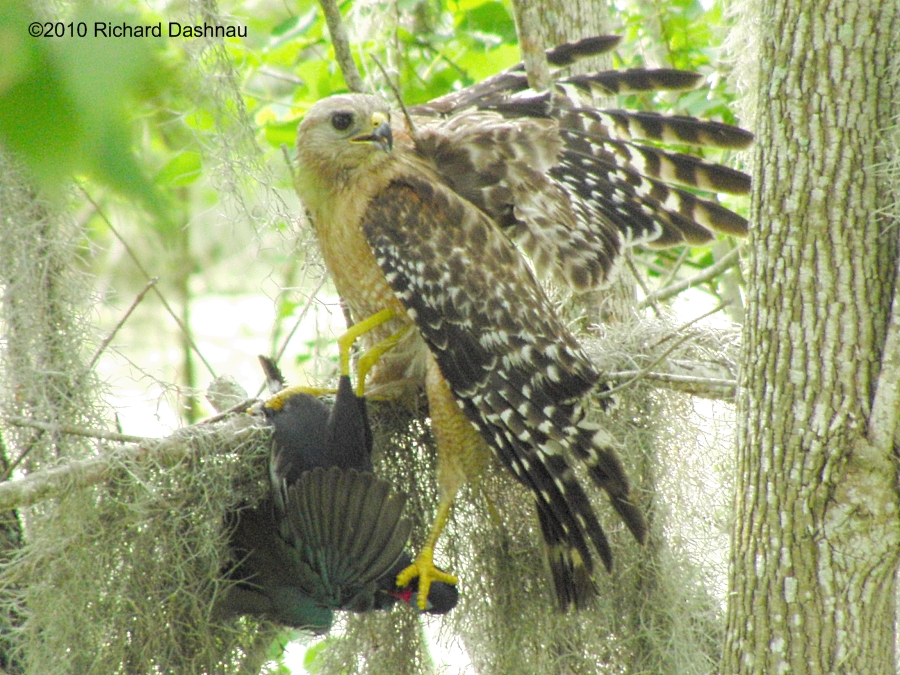 -------------
-------------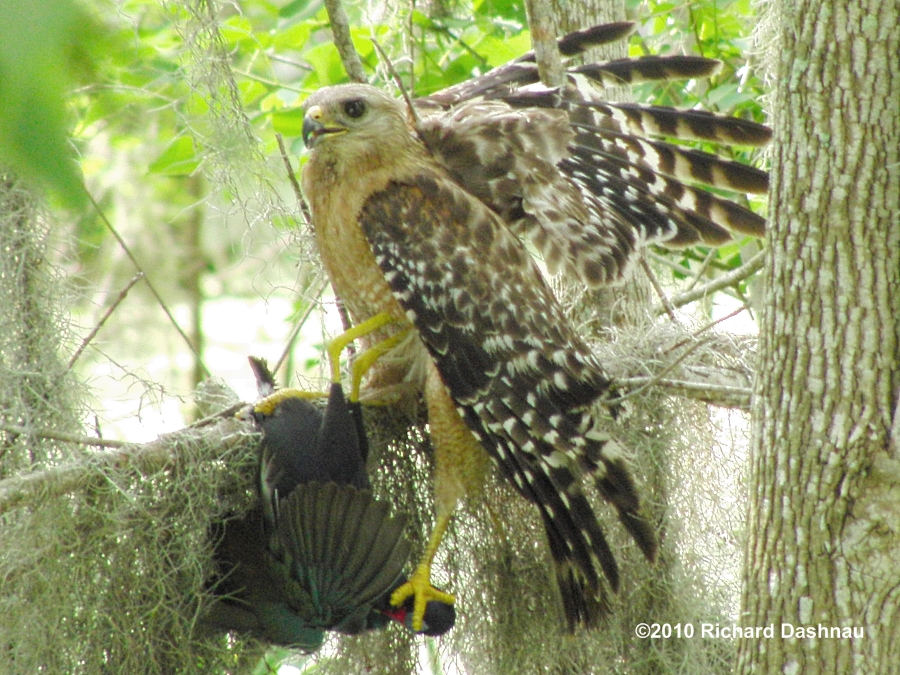 -------------
-------------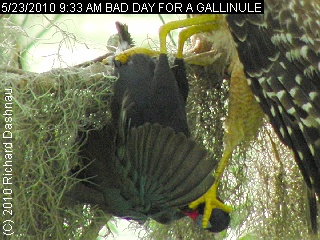
HAWK WITH PURPLE
GALLINULE
HAWK WITH PURPLE GALLINULE IMAGE 2
---------------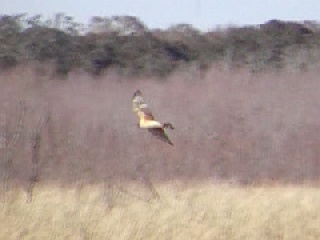 --------------
--------------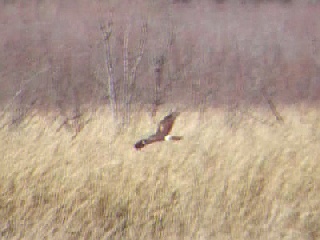 ----
----
HARRIER
BELOW
HARRIER ABOVE
A
little
later that same day (that's Feb. 12) I was able to see a Red-Shouldered
Hawk eating a frog. The images below are frames from video that I shot
of this hawk eating. I've made three shorter clips
from this video. The
first image below (HAWK PICNIC) is from clip
one (wmv 2433kb).
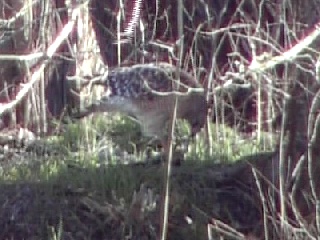 -
-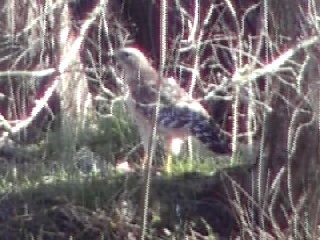 -
-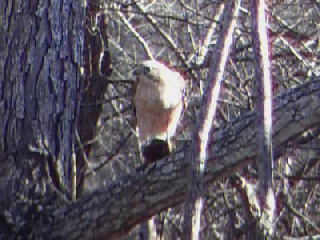 -
-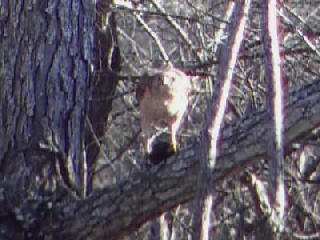 ----
----
HAWK
PICNIC
FROG BETWEEN MY
TOES
DINING
UPSTAIRS
ABOUT TO FLY
The
next image (FROG BETWEEN) is from clip
two (wmv 2785kb). The last two images above (DINING UPSTAIRS,
and ABOUT
TO FLY) are from
clip
three (wmv 7059kb). I've also been able to see other
Red-Shouldered
Hawks hunting. And finally, I was able to see an Osprey
hunting,
and
even got a far view of a successful dive and capture. The image below
left
(HAWK SENTINAL) is a picture of a Red Shouldered Hawk that I
photographed
on February 19.
Next (HAWK FLYING) is a picture
taken as it
flew off. These were taken right next to the Observation
Tower.
---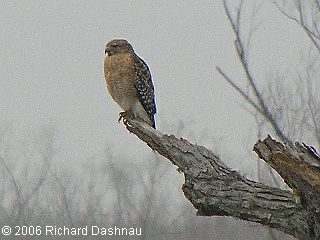 ------------
------------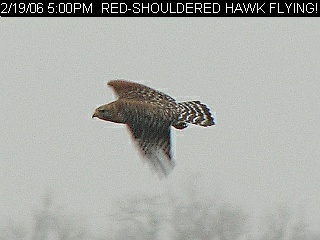 ---
---
HAWK SENTINEL
HAWK FLYING
Added
03/07/06: On Feb. 26, I was able to watch an Osprey
hunting
over 40 Acre Lake. It usually didn't get very close, but the 25x
optical
zoom on the camcorder brings it close
enough to see.
The
image below (OSPREY PASSING) is a frame from this short
video clip (wmv 5676kb) of the Osprey. This new digital
camcorder captures
"interleaved" video
frames, which makes taking single frames from the
video
very difficult.
-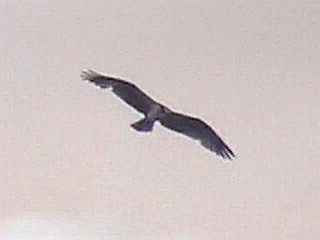 -
-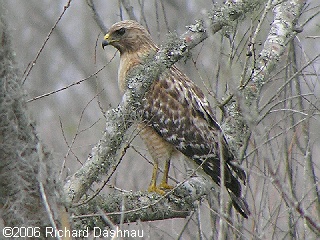 -
-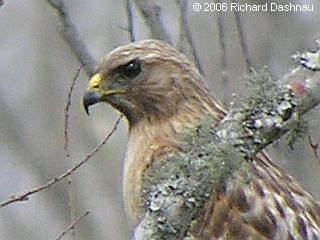
OSPREY PASSING
BY
RED SHOULDERED
HAWK
IT SEES ME
We
were
able to watch the Osprey for a while, and it would do the "hover"
maneuver
shown in the clip from time to time. The Osprey appears to be watching
intently
while hovering. We did see the Osprey dive, but it was on the other
side
of the island. It came up with a fish, and ate it on a treetop.
On
March
5th, I didn't get to
see the Eagle (OK, maybe
not "the" Eagle, but perhaps one of the Eagles), but I saw a number of
Red-Shouldered Hawks before I went inside to present a
program. I got a
few good photos of one of them. The pictures above (RED SHOULDERED, and
IT SEES ME) are cropped from the best one.
I'm
not a "birder", that is, a person with a strong interest in birds. I
believe
I've stated that here before. But, like many people, I'm awed by the
beauty,
majesty and power of the raptors. Where; ANYWHERE;
can one go to
see so many types of wild raptors actively hunting in their natural
home?
It's
been terrific!
January
23, 2005
Today's RICKUBISCAM shows a Red-Shouldered Hawk in flight. An event
like
this is difficult to catch on film, so the image is blurry. I hope that
you will find the pictures
below a bit more satisfying. I was driving
down
the "Mile Stretch" at Brazos Bend State park, when my attention was
captured--for
some reason--by the top of a dead tree. I saw this (see
WHAT'S UP THE
TREE?,
below). As I drove by, I saw that it was a hawk! I drove a
bit further,
then turned around, and drove past the tree again. The hawk remained in
place, so I turned
around again, and slowly moved across from the tree.
Much to my pleasant surprise, the hawk didn't move, and I shot more
pictures.
Look how the top plumage matches the bark pattern.
I almost missed
this!
These were shot with an Olympus C-750 (10x optical zoom).
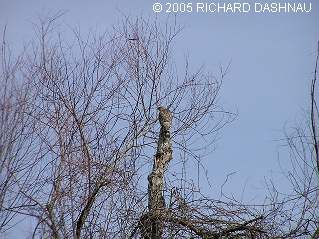 -
-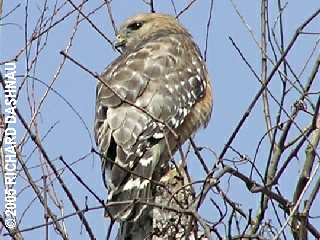 -
-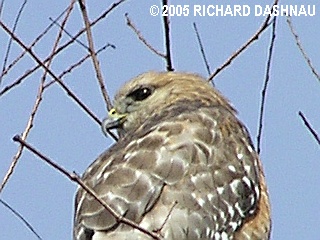
WHAT'S UP THE
TREE?
LOOKING
BACK
LOOKING
BACK-CLOSE
-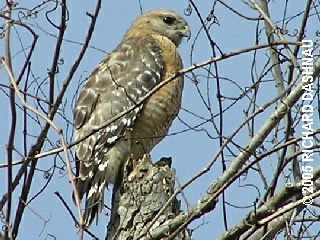 -
-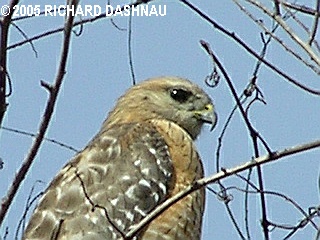
VIGILANT
BEAUTY
VIGILANT--CLOSE
Although
I often encounter these hawks in the park, they are usually too far
away
for me to see (or catch with a camera). I've mentioned before that I am
not a "birder". That is, I don't spend a lot
of time watching and
identifying
birds. But, there is something about the sight of a bird of prey (hawk,
eagle, owl, kestrel, even a shrike) that stops me dead in my tracks. It
was an fantastic treat
to be just below this bird as it surveyed the
area
with those piercing black eyes. After tolerating my presence
for
about 10 minutes or so, the hawk took off, and the RICKUBISCAM
picture
resulted from my attempt to catch it in flight. What a magnificent
sight!
But, I always say that, don't I?
Brazos Bend State Park The main page.
Brazos
Bend State Park Volunteer's Page The
volunteer's main page.
Go back to my home page, Welcome
to rickubis.com
Go
back to the RICKUBISCAM
page.
Go
back to the See
the World
page.